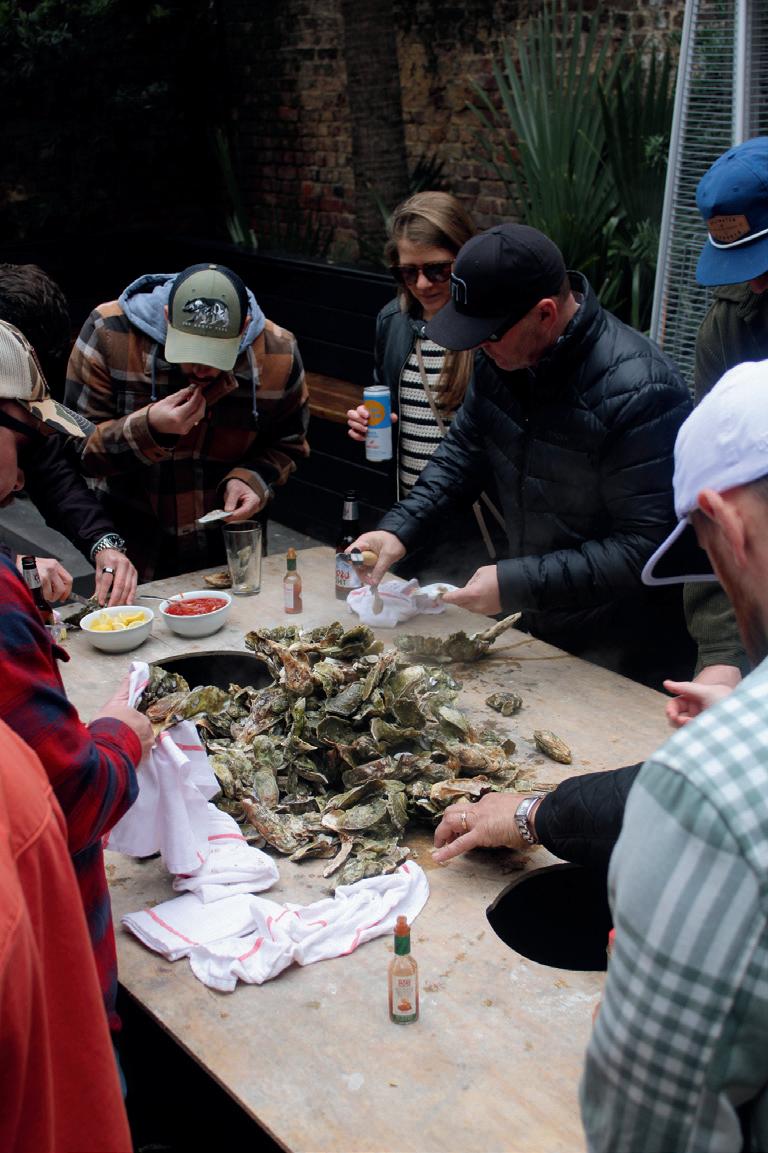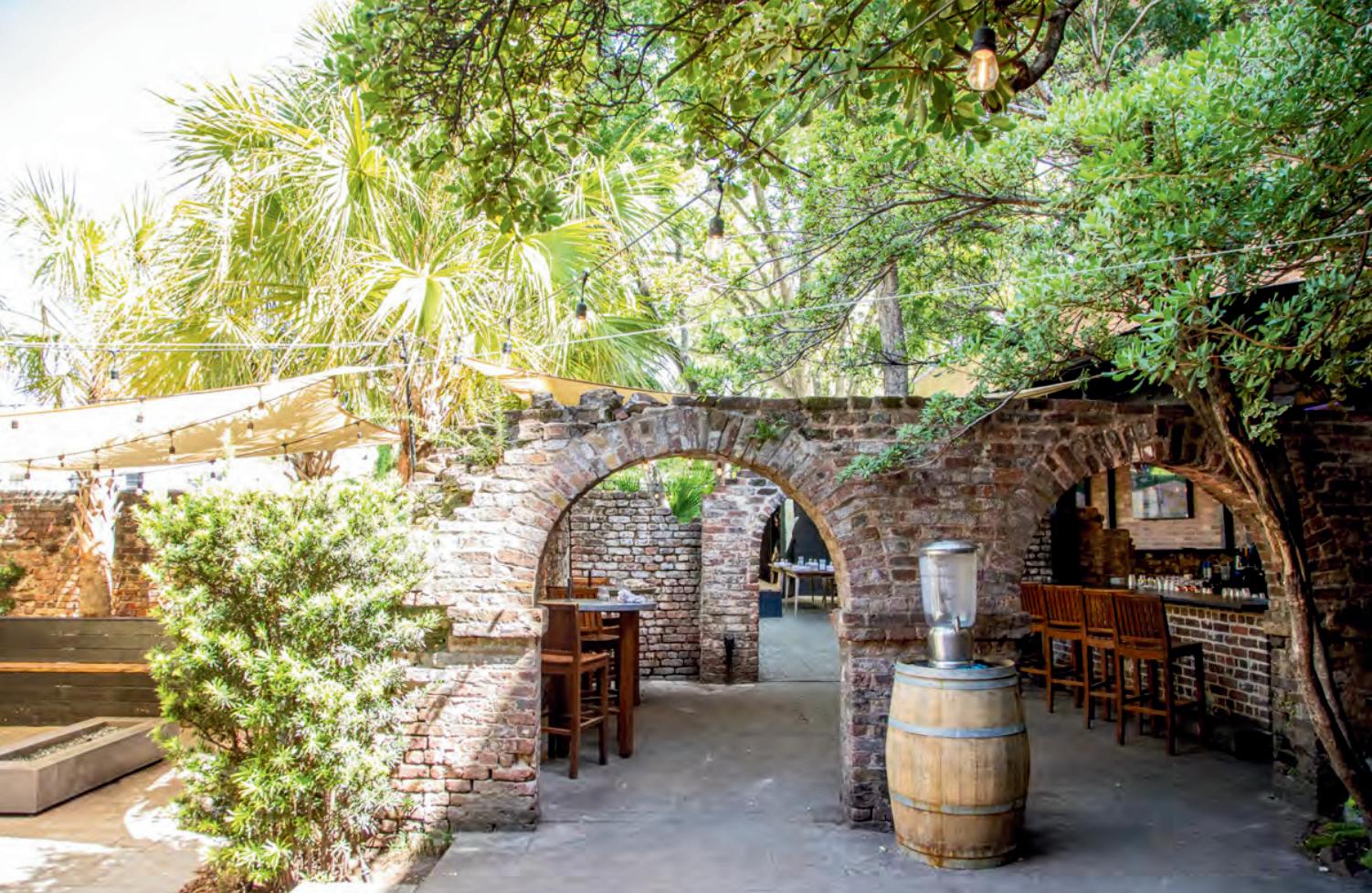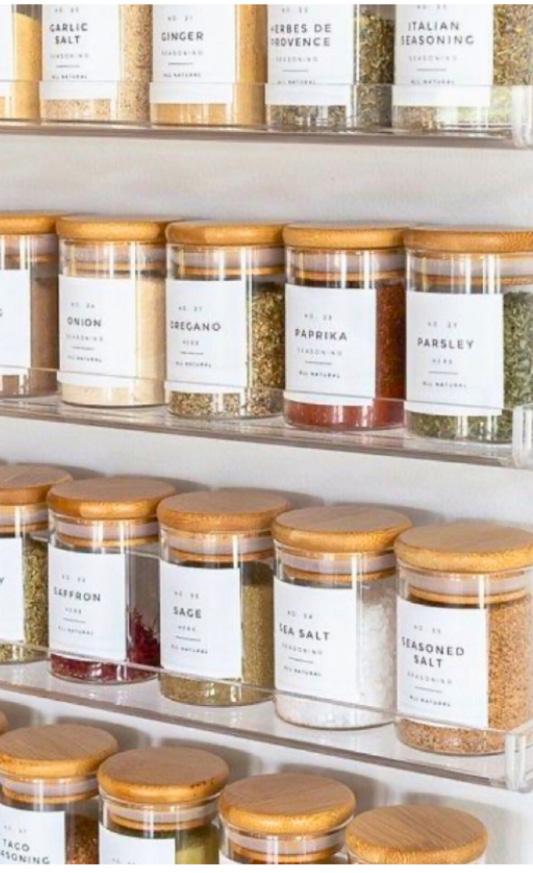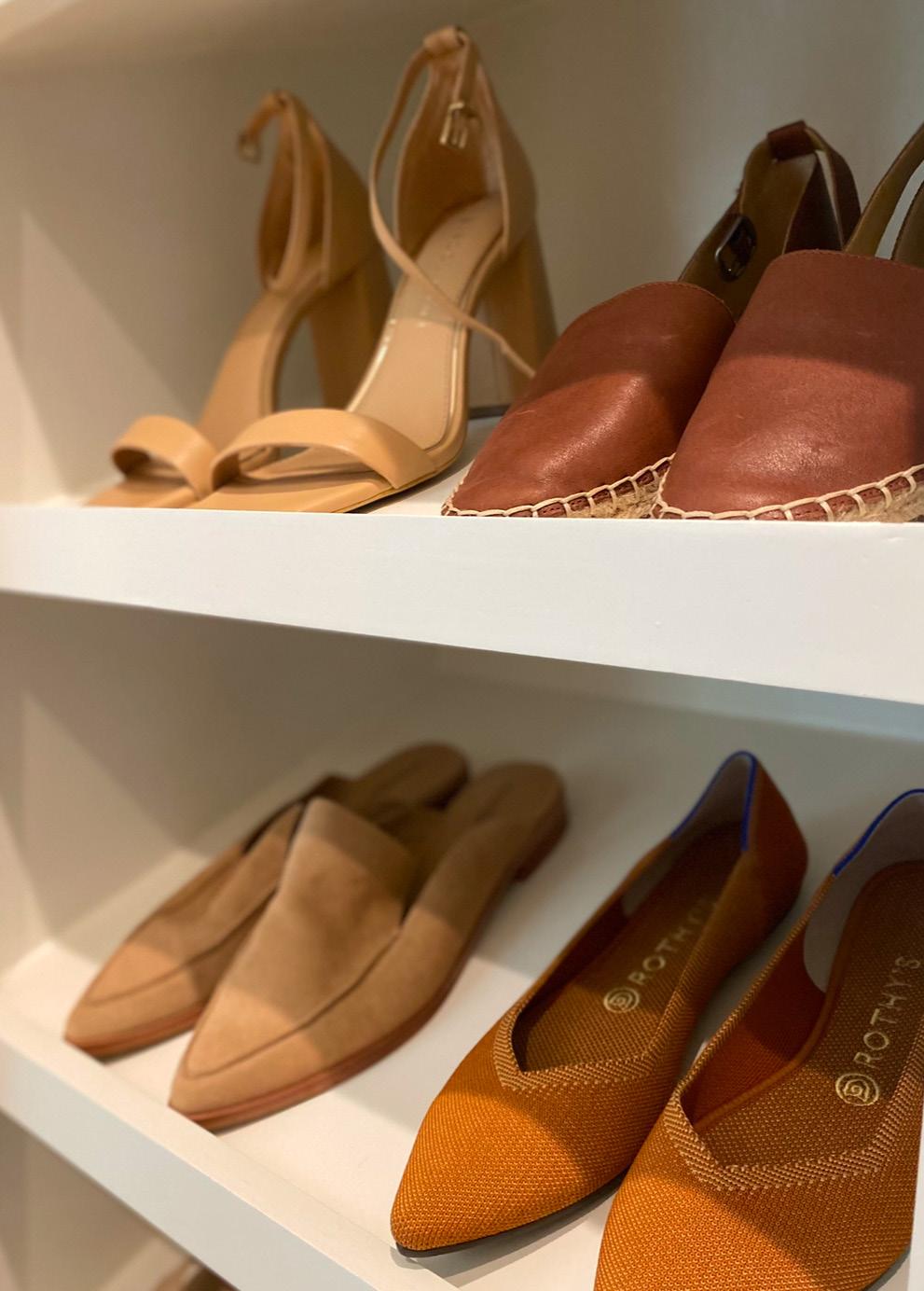

PENINSULA CHARLESTON
“Art
of the Plate” with Daniel Dalton

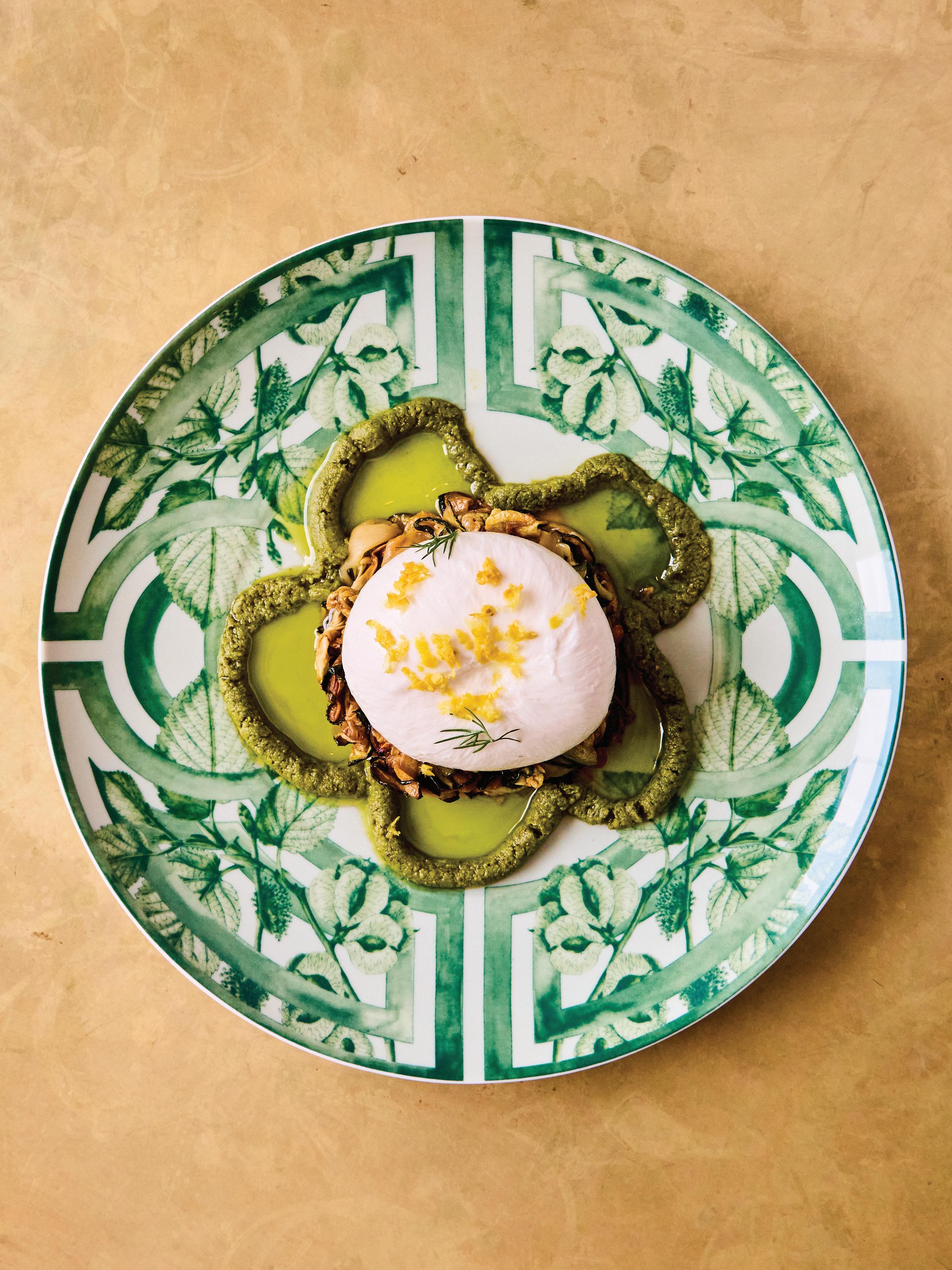
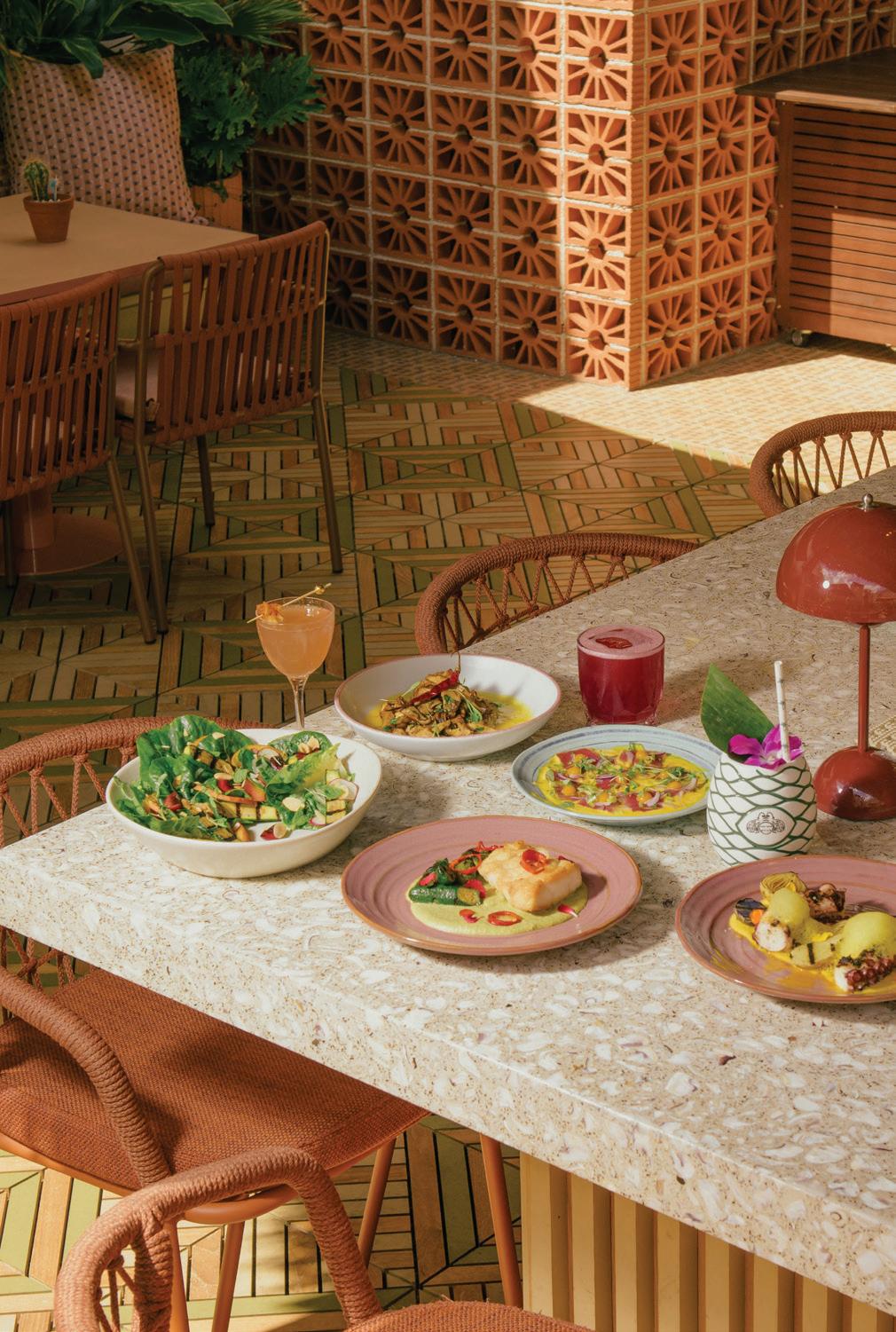


A COASTAL EXPERIENCE
Open-Air Restaurant & Bar with a Vibrant Spirit
Little Palm—your tropical retreat in the heart of Charleston. We’re here to bring the vibrant coastal spirit to every moment, from brunch to nightfall. Indulge in our tropically inspired menu, created for sharing, and savor the flavors of the coast across Little Palm’s layered spaces – be it poolside, a vibey restaurant & bar, or lush open-air Backyard.


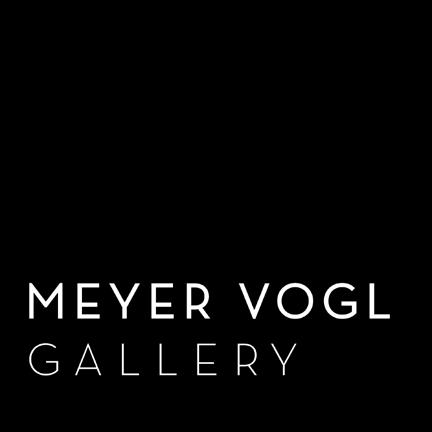
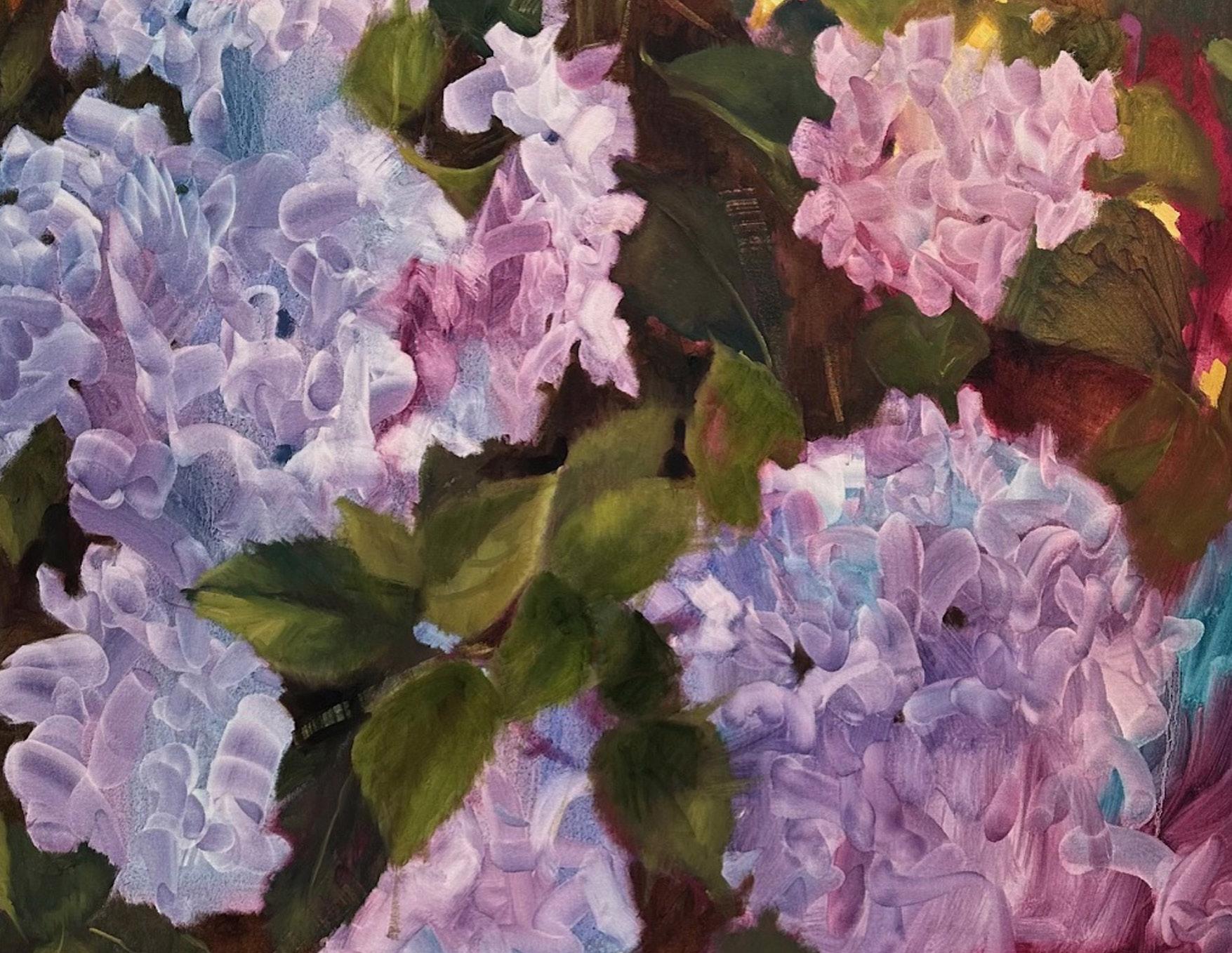


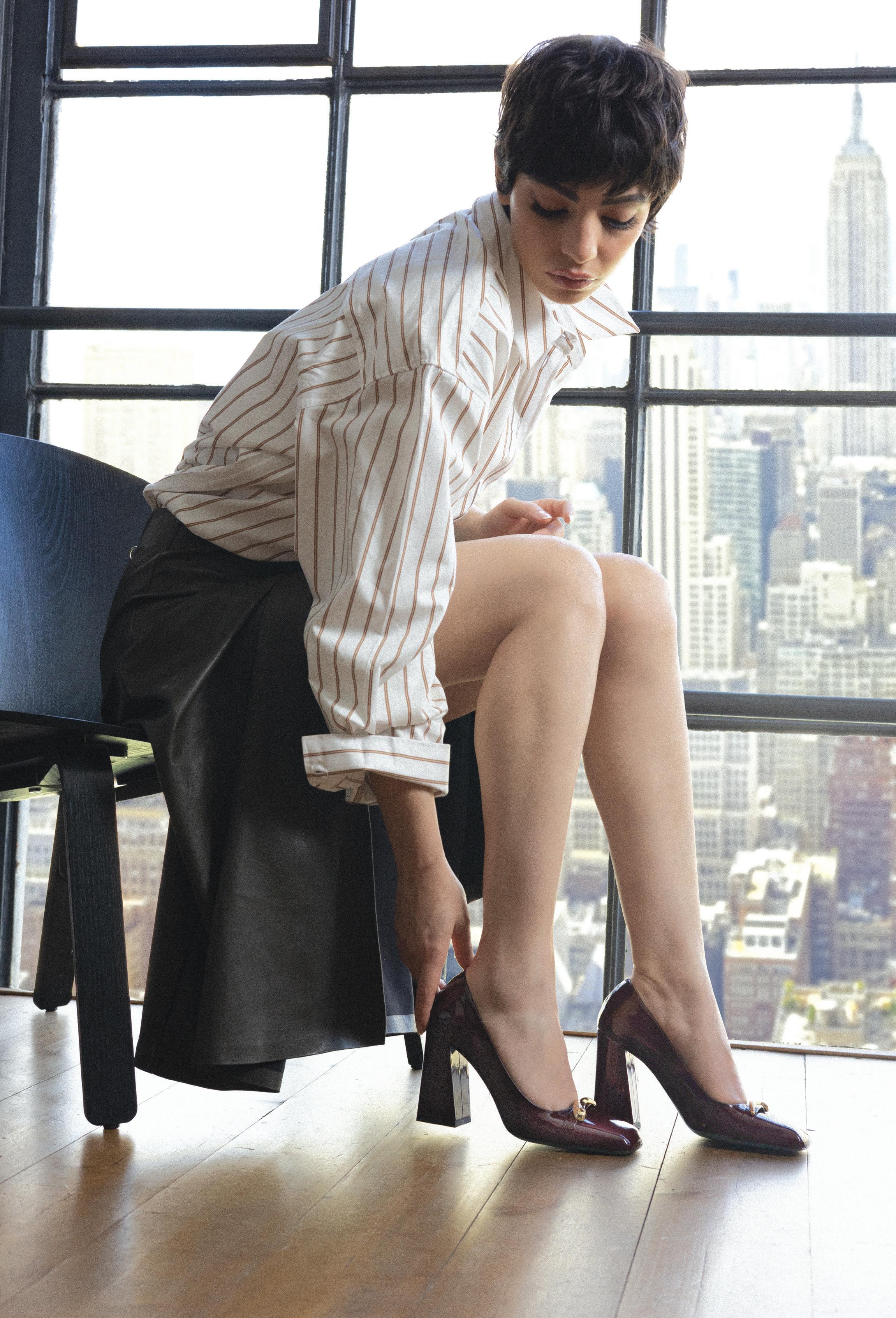

A Little About Editor: Christina Coscia
As the founder of Home Simplified, I’ve spent my career helping people create beautiful, functional, and intentional spaces. But beyond organizing closets and curating homes, I’ve discovered a deeper passion: bringing creativity behind the scenes whether in a home, an event, or a publication.
Joining Peninsula Magazine as an editor allows me to merge my love of art, design, and storytelling, crafting features that inspire readers while celebrating the vibrant culture of Charleston. There’s a special magic in taking an idea from concept to creation, in turning behind-the-scenes planning into something both elegant and meaningful.
Charleston is a city that thrives on community, and I’ve always believed that true impact comes from giving back. As a philanthropist at heart, I dedicate time to local organizations and nonprofits, supporting initiatives that enrich our city and bring people together.
Through my work at Peninsula Magazine, I hope to share that love of art, design, and giving with readers, highlighting the stories, people, and experiences that make Charleston a place worth celebrating.



C he f G ra ha m
Graham Calabria has quickly emerged as one of Charleston‘s premier Chefsblending his Southern roots, heritage, and eclectic culinary background with an innovative style to create truly unique flavors and experiences.







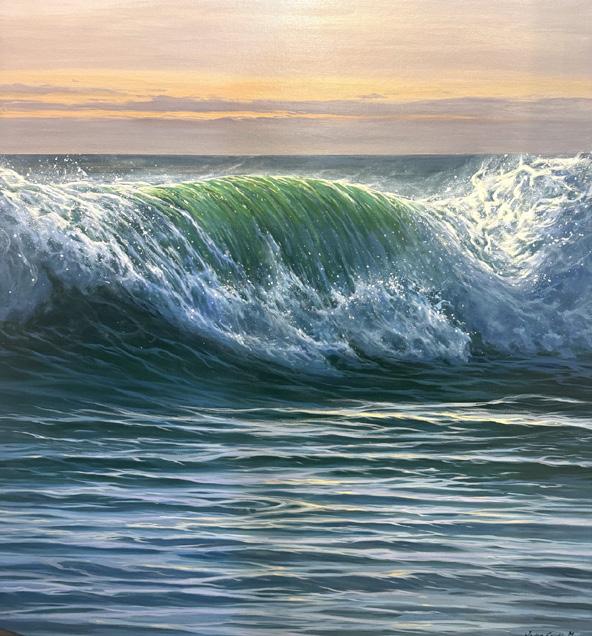
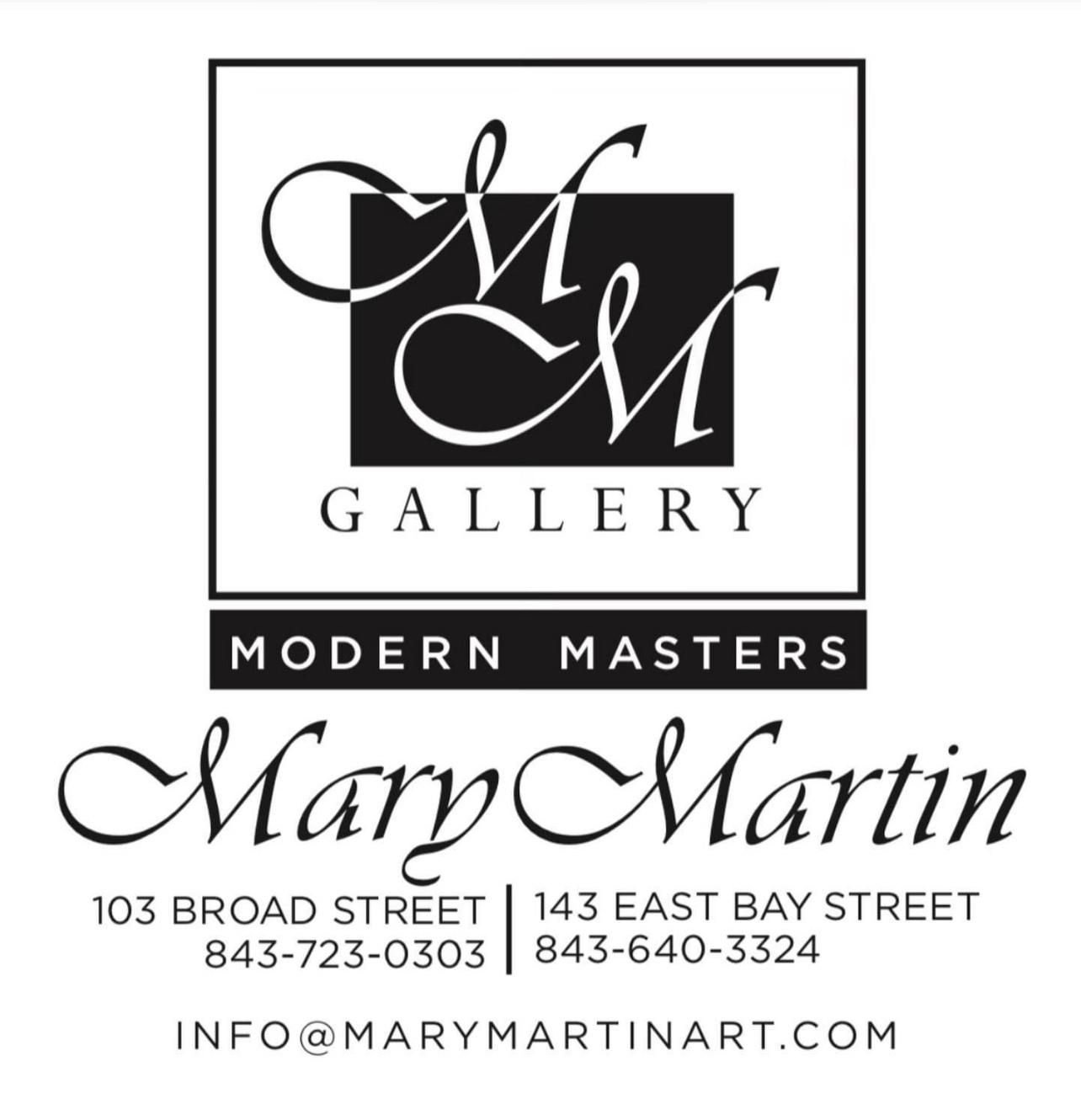






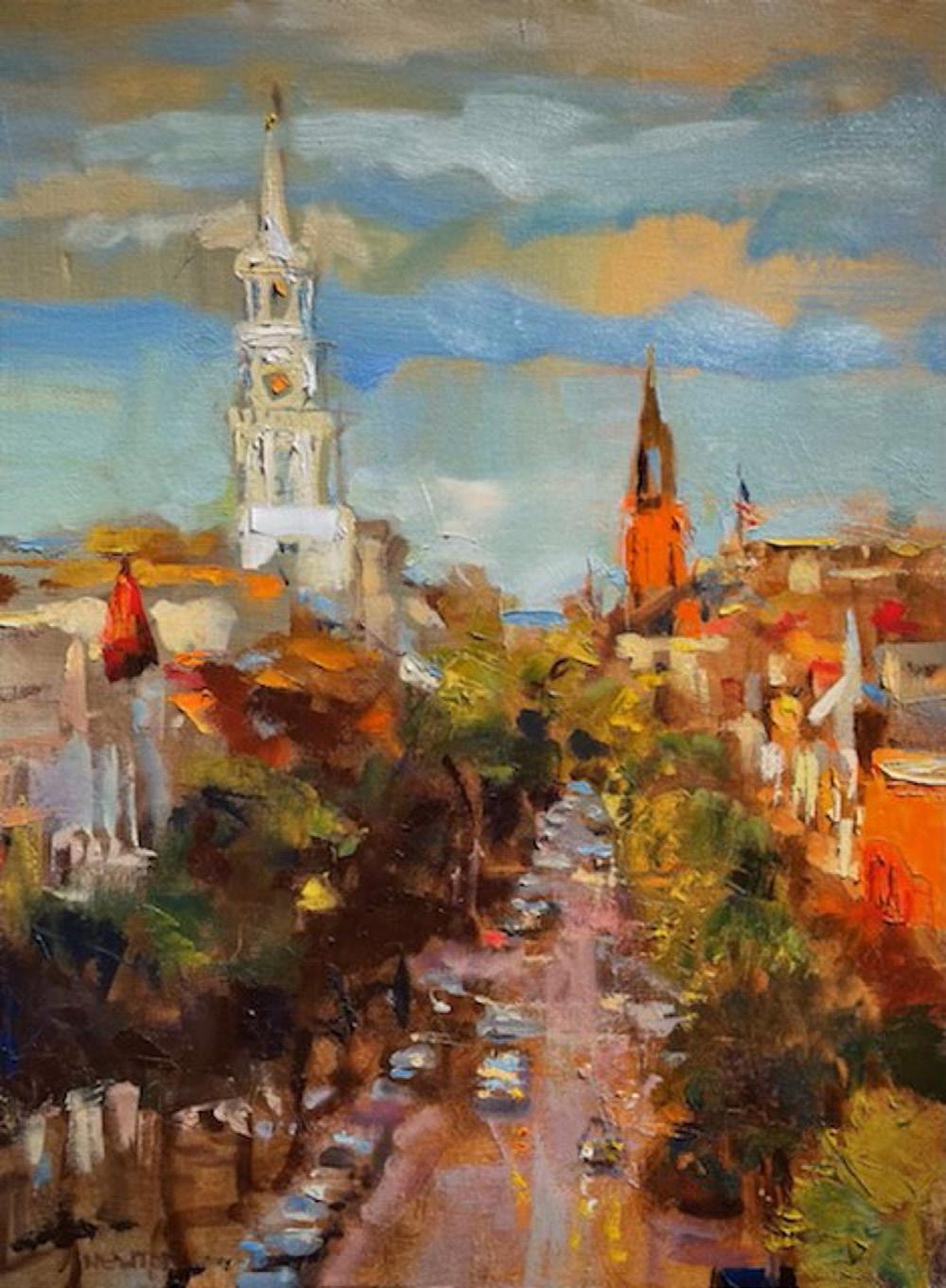





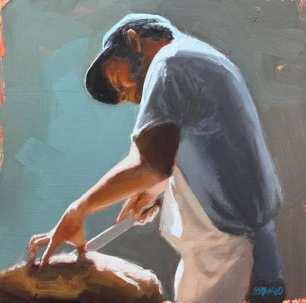

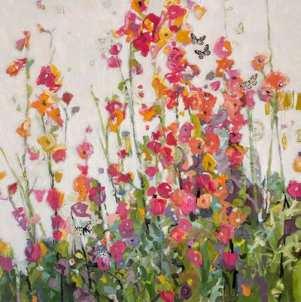

Since


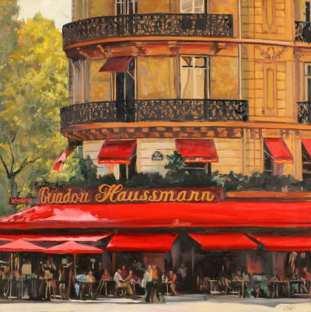

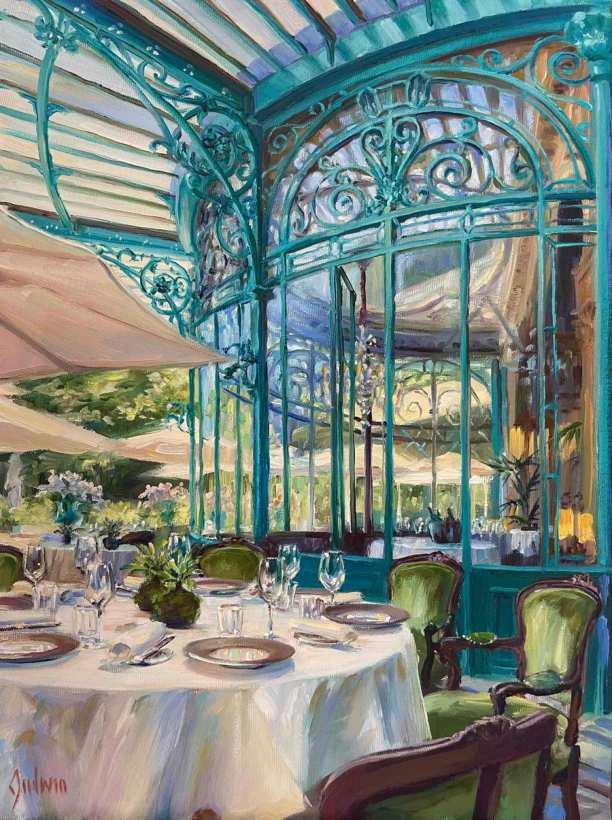


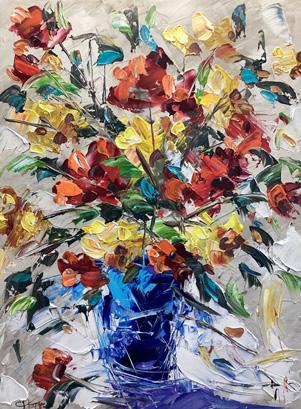


An International Celebration of Art in the Heart of Charleston
Located in the historic French Quarter at 13 Broad Street, the Frederic Payet Gallery is a vibrant and refined art space showcasing a curated collection of works from internationally acclaimed and emerging artists. Our gallery represents a diverse range of styles and cultures, with a strong emphasis on color, emotion, and contemporary expression.
Founded by artist Frederic Payet, whose own paintings are known for their vivid palette knife textures and powerful color vibrations, the gallery now proudly features exceptional works from painters, sculptors, and mixed-media artists from across Europe, the Americas, and beyond. Each piece on display is selected for its originality, craftsmanship, and emotional resonance.
Whether you're an avid collector, a design professional, or simply a lover of fine art, our gallery offers a unique opportunity to explore international creativity in an intimate and elegant setting.
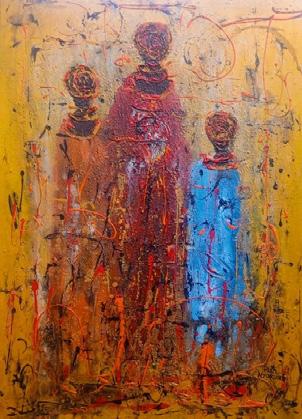
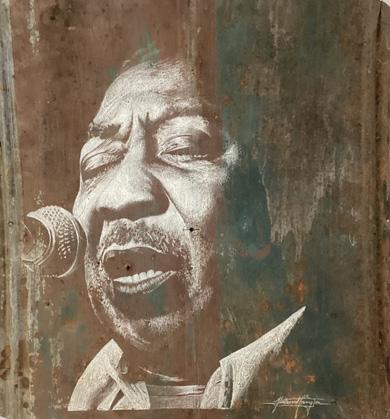


Frederic Payet
Ruth Nyakundi Fleetwood Covington Katarzyna Zygadlewicz Serge Lescure Kenyan American Polish French
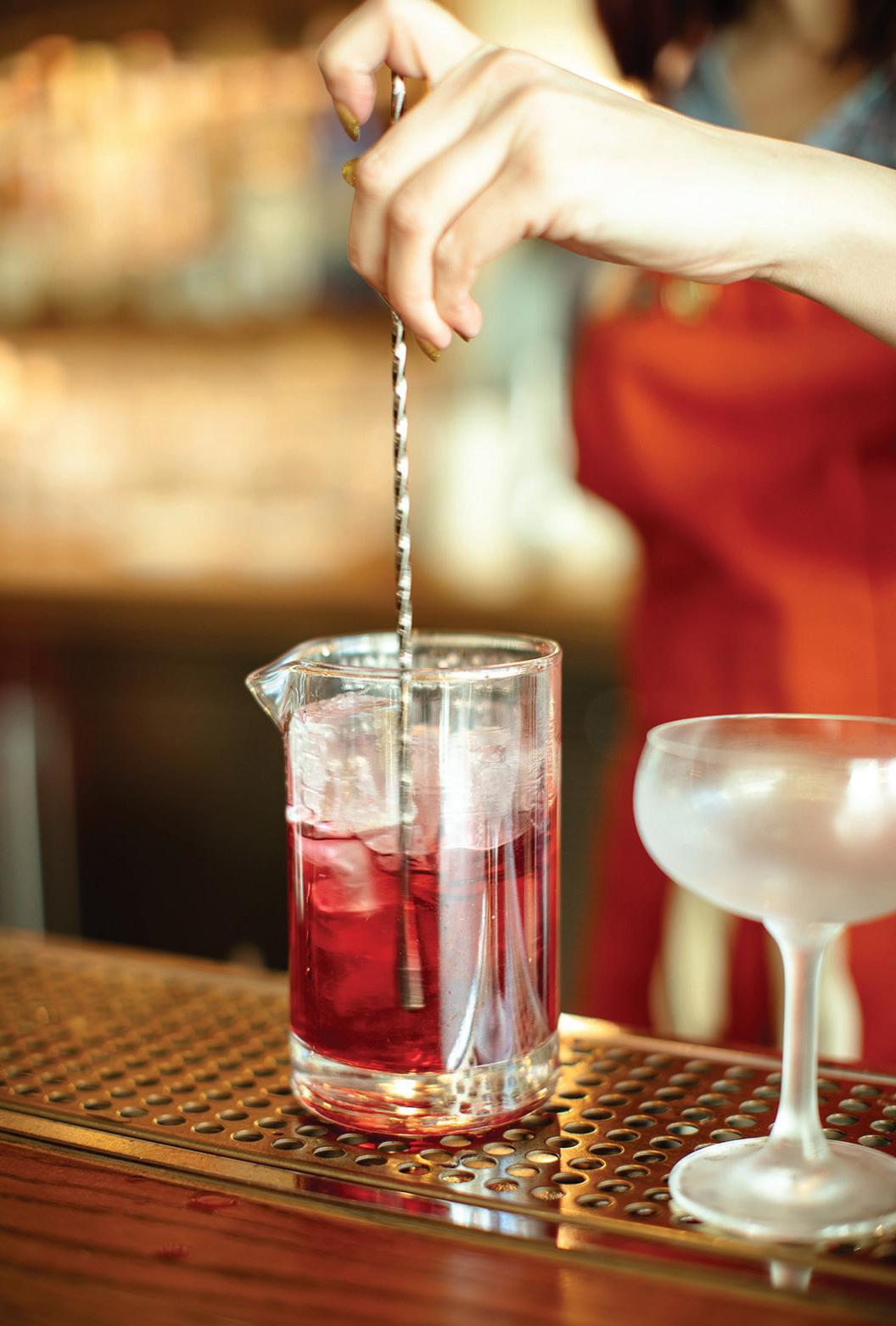
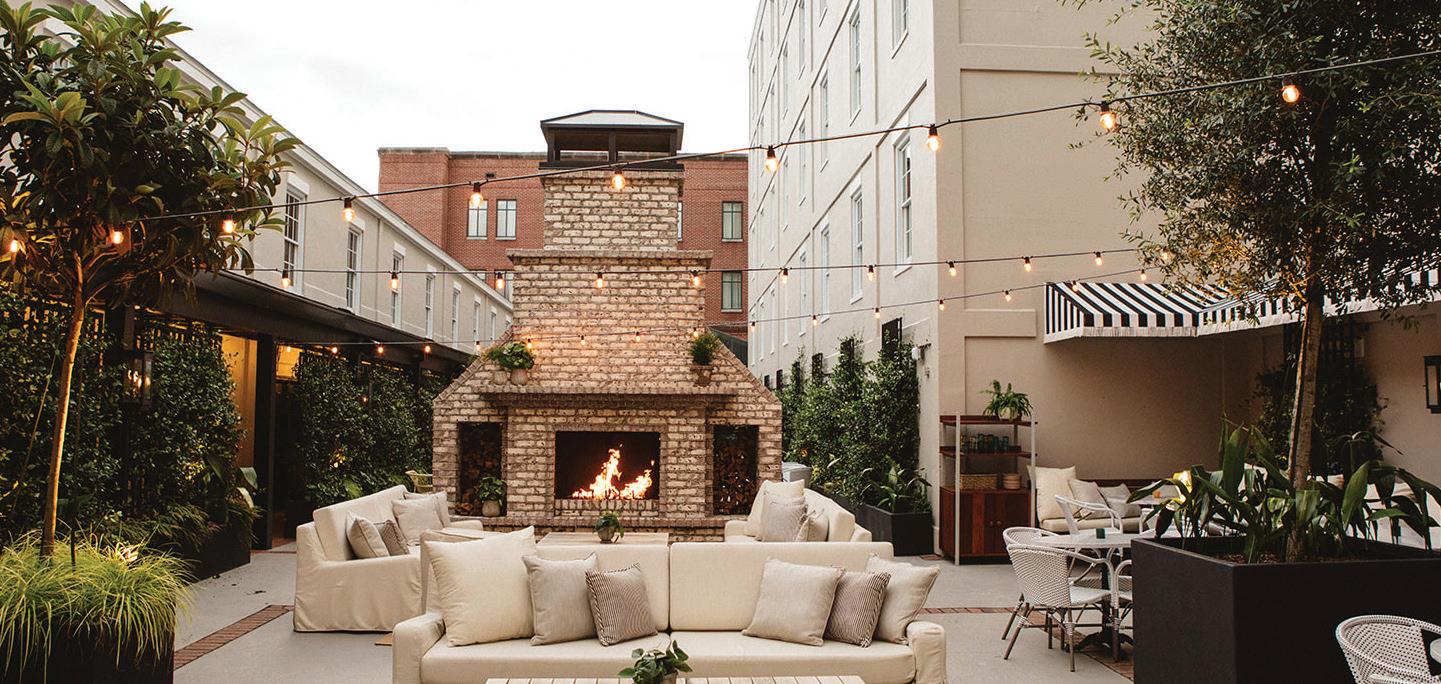

WOOD-FIRED EATERY
Serving American ingredients with Italian sensibilities
For the adventure seeking, campfire loving, culinary enthusiast in us all, Frannie & The Fox presents a wood burning concept of shareable dishes. Whether you’re a guest of the Holy City or a Charlestonian, you will find a warm and engaging environment anytime. Serving regional ingredients in an honest and straightforward environment. The menu features shareable and thoughtfully sourced dishes from local purveyors.


CHARLESTON CONTEMPORARY
NOV/DEC 2025



Handcrafted Anatolian Jewelry
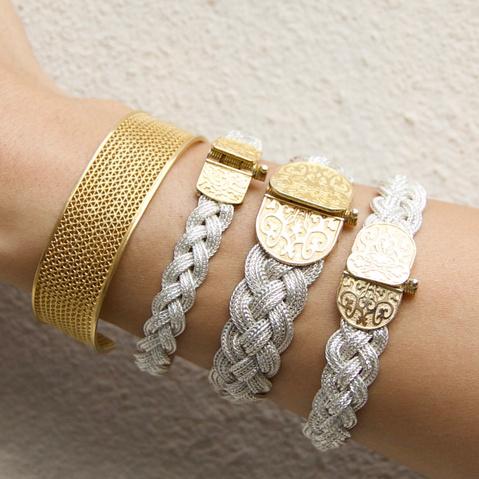



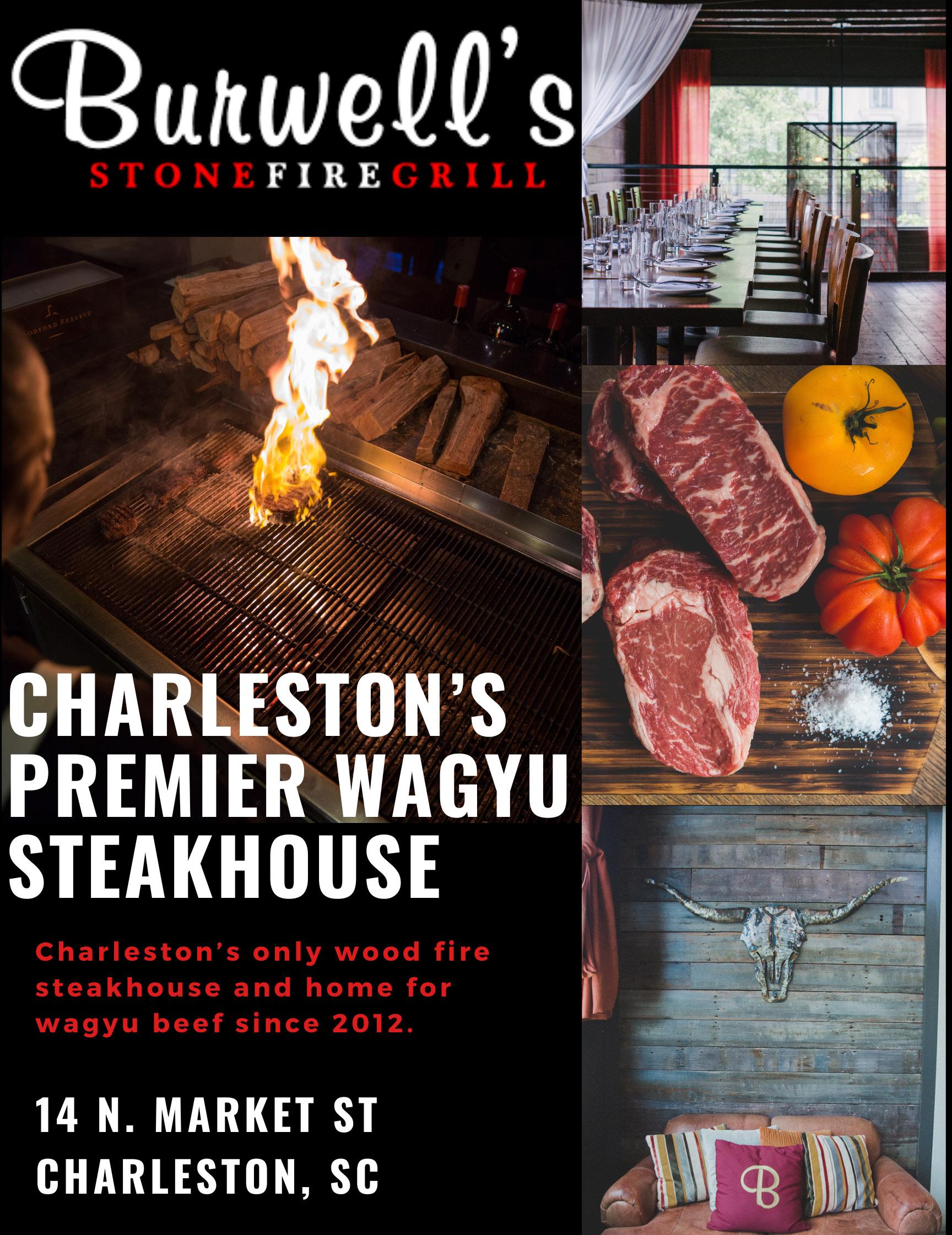




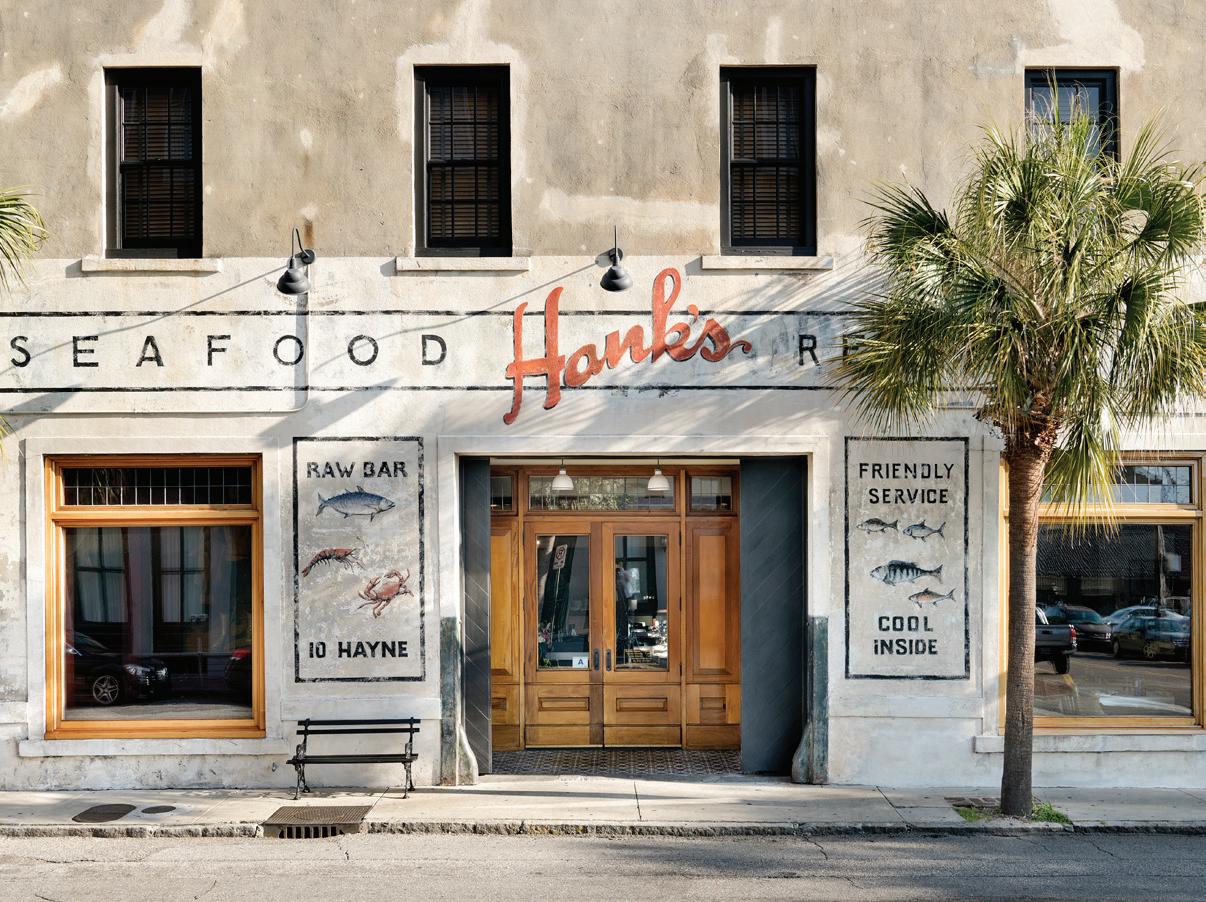
CLASSIC LOWCOUNTRY SEAFOOD
For over 25 years, Hank’s Seafood has been a beloved staple for both Charleston locals and visitors, offering the freshest local, sustainably sourced seafood. Guests can enjoy the signature dishes that have made Hank’s Seafood an iconic dining destination, as well as the high standard of quality they’re known for, serving sustainably sourced seafood. Hank’s is open daily for dinner and will begin serving lunch starting October 2.
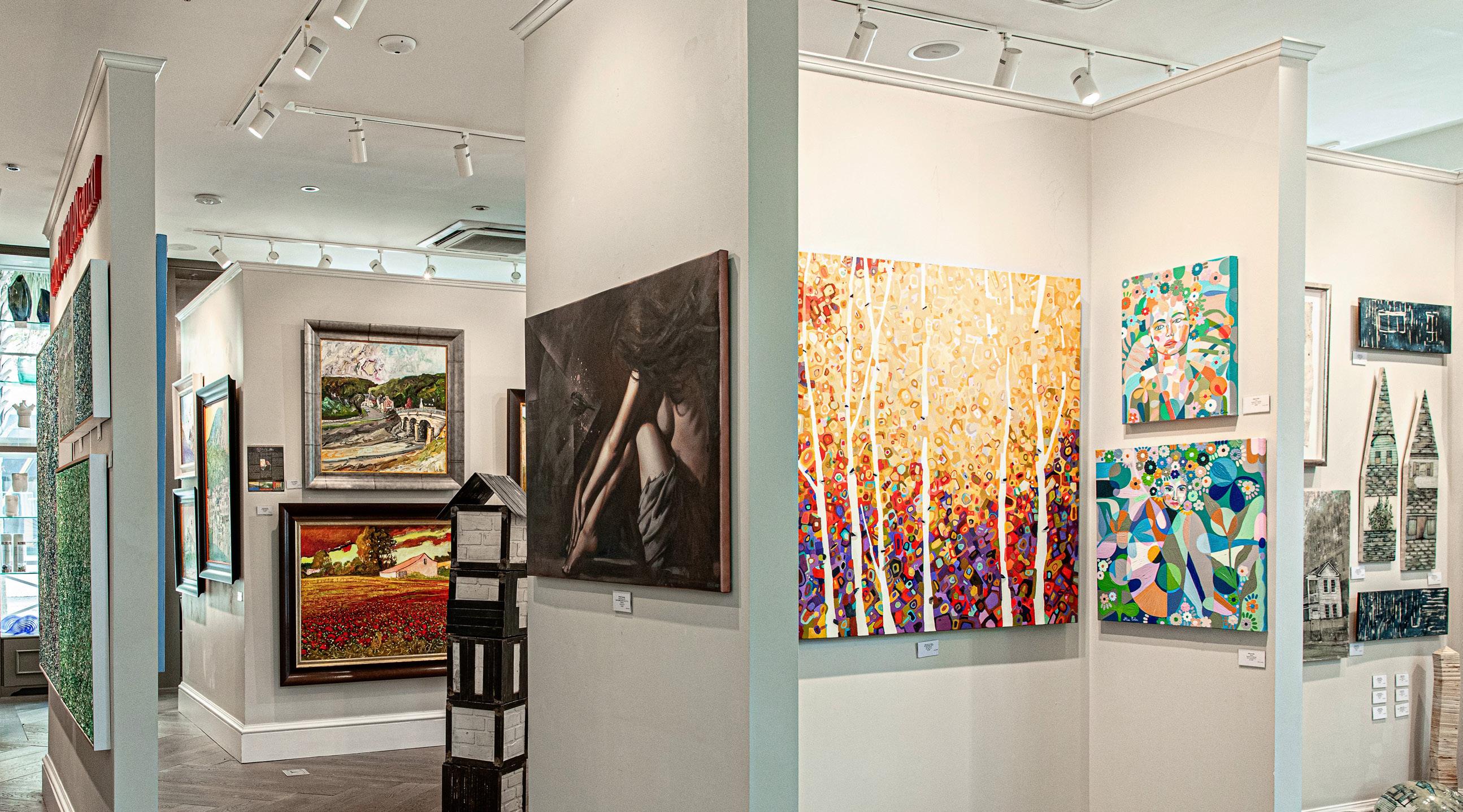
LEAVE THE FAMILIAR BEHIND
Wander into the Grand Bohemian Gallery and uncover something unexpected. Located within Grand Bohemian Charleston, explore a curated collection of fine art — from original paintings to handcrafted jewelry, glasswork, and more.
DISCOVER YOUR NEXT MASTERPIECE.
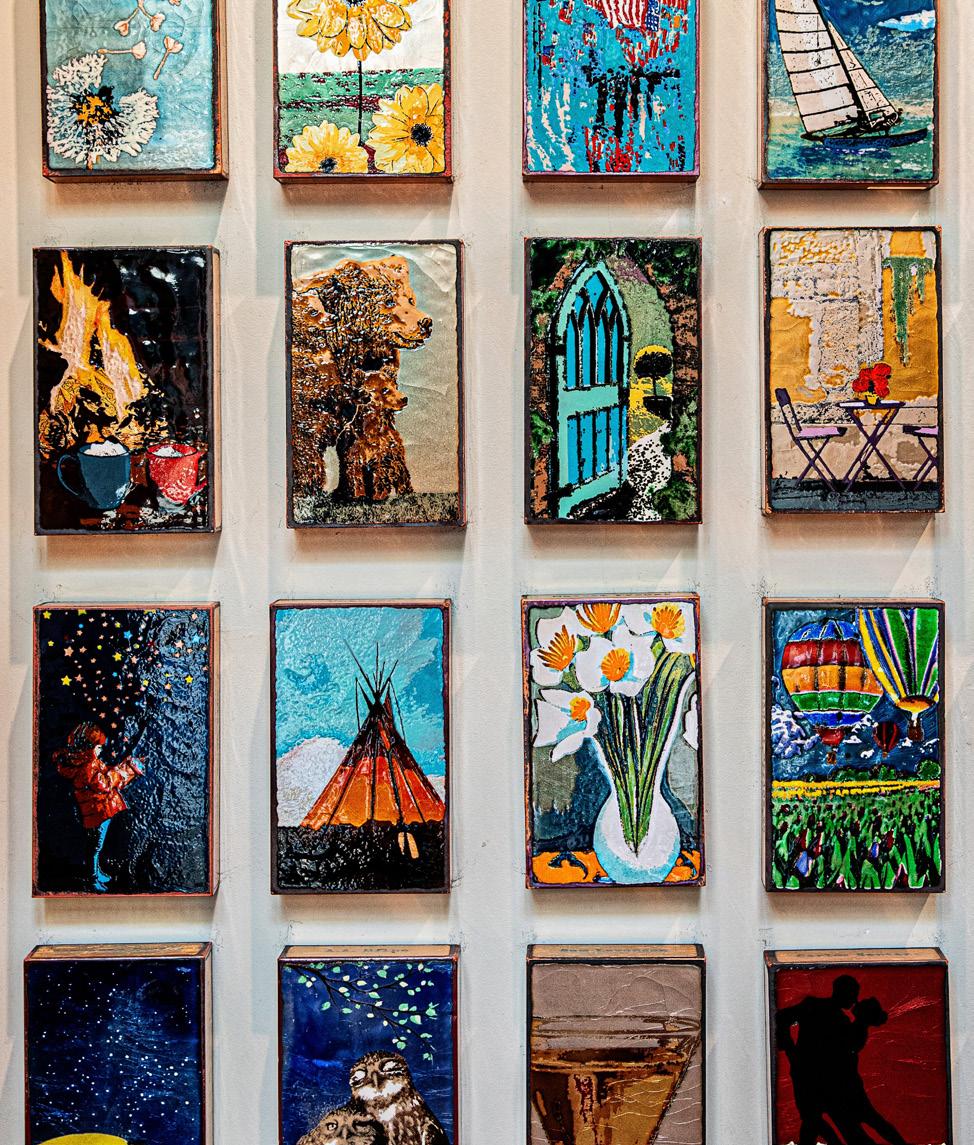
FEATURED ARTISTS
Liv Antonecchia · Michael Arnett · Christy Boaman · Cece Burnett · Jean Lee Cauthen ·
Charles Clary · Alice Colin · Sid Dickens · Viz Glass · M Jason · Abra Johnson · Morgan Kinne · Jorge Lastra · Houston Llew · Gretta McCall · Jenan McClain · Anna Razumovskaya ·
Lauren Ridenour · Taylor & Connor Robinson · Jean Claude Roy · Samantha Rueter · Chris Sedgwick · Linda Sperruzzi · Lue Svendson · Pam White · Juliann Whitwell · Stephen Wilson
FEATURED JEWELRY ARTISTS
Kristen Baird · Brackish · J. Catma · Kate Furman · Teal Heron · Mara Labell · Melinda Lawton · Jenan McClain Designs · Lauren Ridenour · ZinniaLou

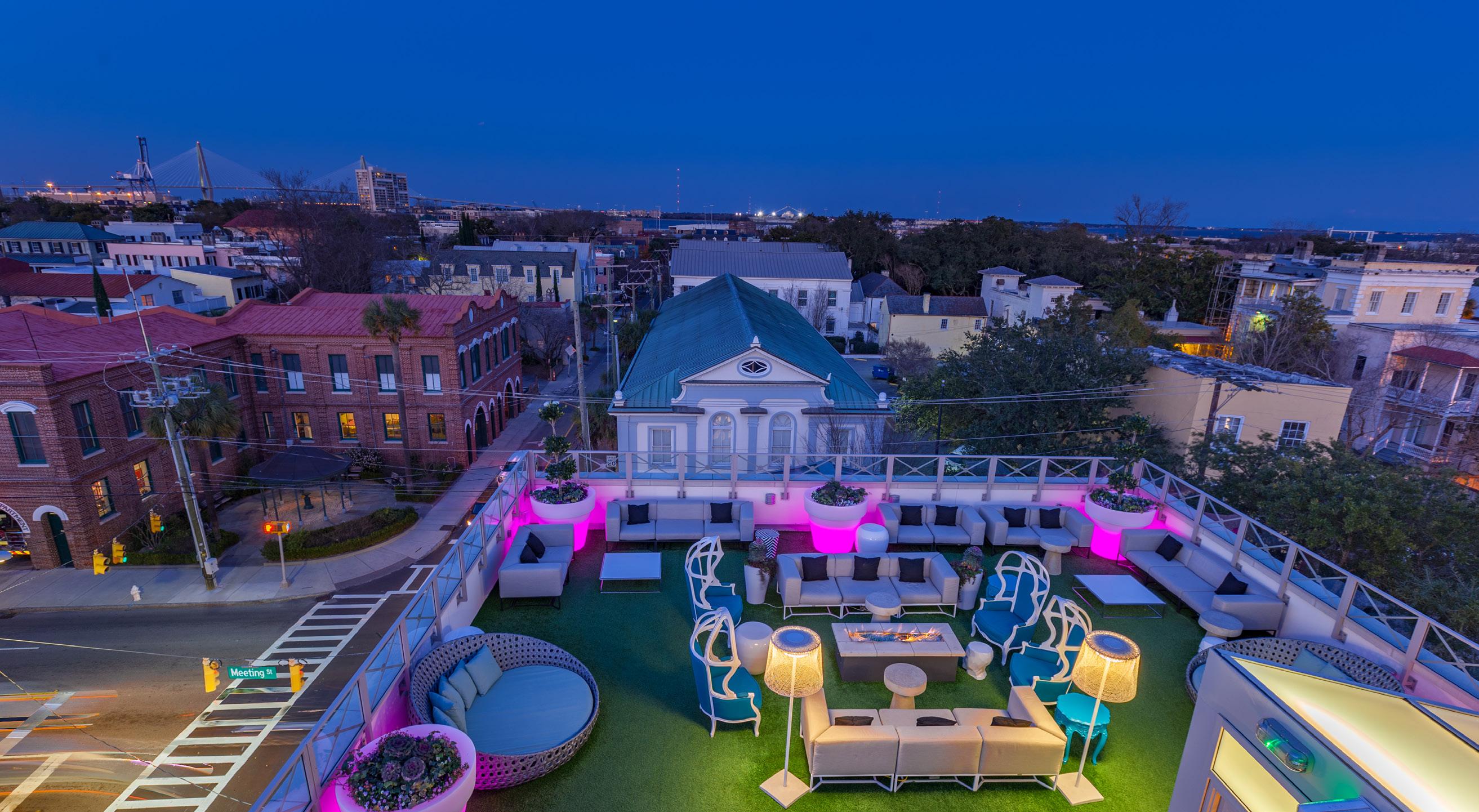

ROOFTOP DINING, ELEVATED
Nestled atop Grand Bohemian Charleston, Élevé blends locally sourced ingredients with bold Southern flavors — all set against a rooftop backdrop that’s as unforgettable as the flavors.
AWAKEN YOUR PALATE
Experience a taste of Élevé as our chefs present inspired bites crafted specially for the evening — a flavorful complement to a night of art, culture, and creativity.
Designing with an Editorial Eye An interview with Alia Bosworth
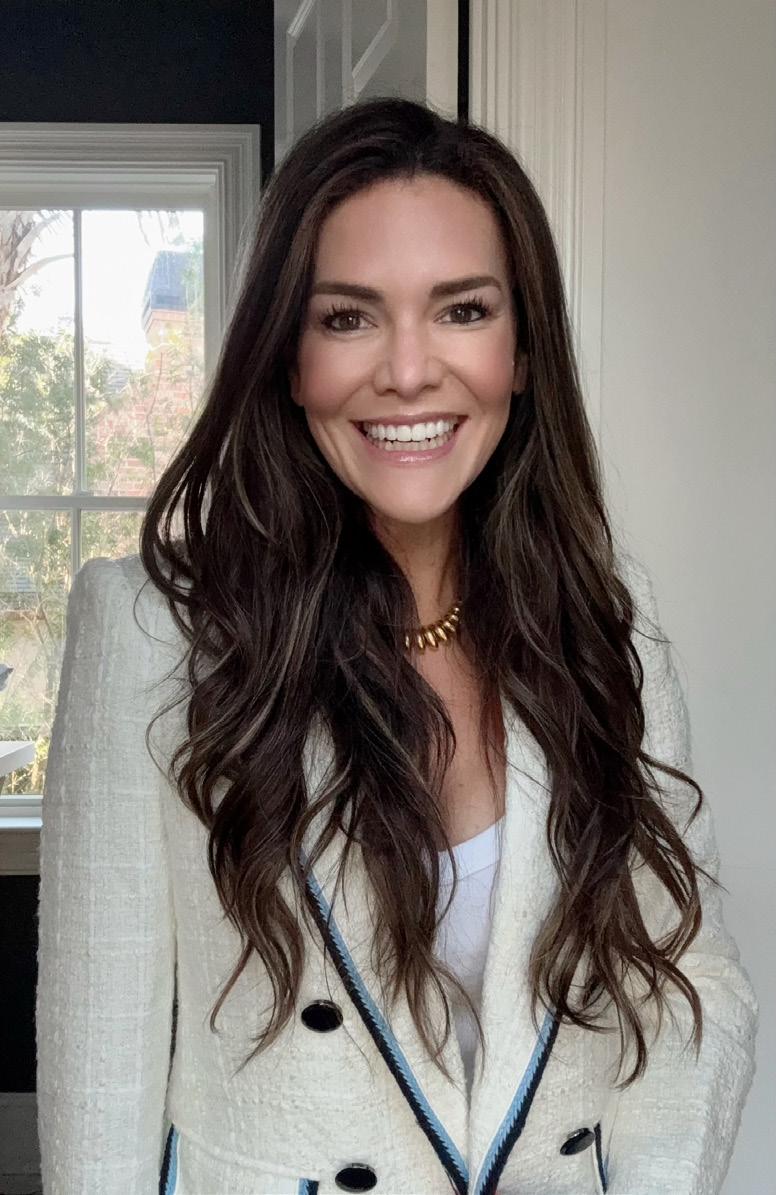
Your career began in fashion, shaping style and stories for global brands. How has that editorial sensibility influenced the way you approach designing a home for a client?
My background in fashion taught me that style is really about storytelling — not just what something looks like, but how it makes you feel. In editorial work, every frame has to capture a mood, a point of view, a narrative. I bring that same lens to interiors. A home should photograph beautifully, of course, but more importantly, it should tell your story. I think in layers — texture, tone, light — the way a stylist builds a look. Every detail is intentional but never overdone.
When you founded Bosworth Custom Design, what was your vision for
creating spaces that feel both elevated and truly livable?
When I founded Bosworth Custom Design, my vision was to create spaces that felt as effortless as they are elegant. Over time, I saw a real gap — clients were investing in beautiful outdoor spaces, but the cost of quality furnishings was inflated by layers of retail and trade markups. After years in the industry, I knew exactly how high those margins ran and how little of that went into craftsmanship or materials.
That realization inspired me to launch Bosworth Bespoke, an extension of my design business dedicated to luxury outdoor furniture sold directly to consumers. By working straight with the factories that produce for top-tier brands, we’re able to offer the same level of design, customization, and quality — without the 40–60% markup. It’s about cutting out the middlemen while keeping every ounce of refinement.
My goal has always been to make luxury smarter: to deliver elevated, livable design — whether through a full home project or a single outdoor collection — that feels both accessible and enduring.
Every designer has a signature. How would you describe yours, and what makes it uniquely Bosworth?
I’d describe my aesthetic as editorial Southern modernism — a blend of New York polish and Charleston warmth. There’s a certain crispness and confidence to the way I design: clean lines, natural textures, and a tonal richness that feels both timeless and modern. I love a space that feels layered, curated, and quietly luxurious rather than overtly styled. Every room I design has one statement piece — a moment that captures attention the second you walk in. It might be a sculptural light fixture, a bold piece of art, or a custom outdoor daybed framed by draped linen. That focal point anchors the space and gives it presence, the way a great piece anchors an outfit. My goal is always the same: to create rooms that could live in a magazine but feel entirely like you.
Your work balances elegance and comfort. How do you ensure that a home feels stylish yet inviting for the families who live there?
It comes down to materials and mindset. I use durable, family-friendly fabrics but elevate them through tone and proportion. I’ll mix performance linen with marble, raffia with lacquer — it’s about balance. I also spend time understanding how my clients truly live. A room only feels inviting if it fits your rhythm: where you set your coffee, where the dog naps, how the light moves. Design is only successful if you want to be in it.
What do you bring to a project that transforms the experience and the home beyond what clients expect?
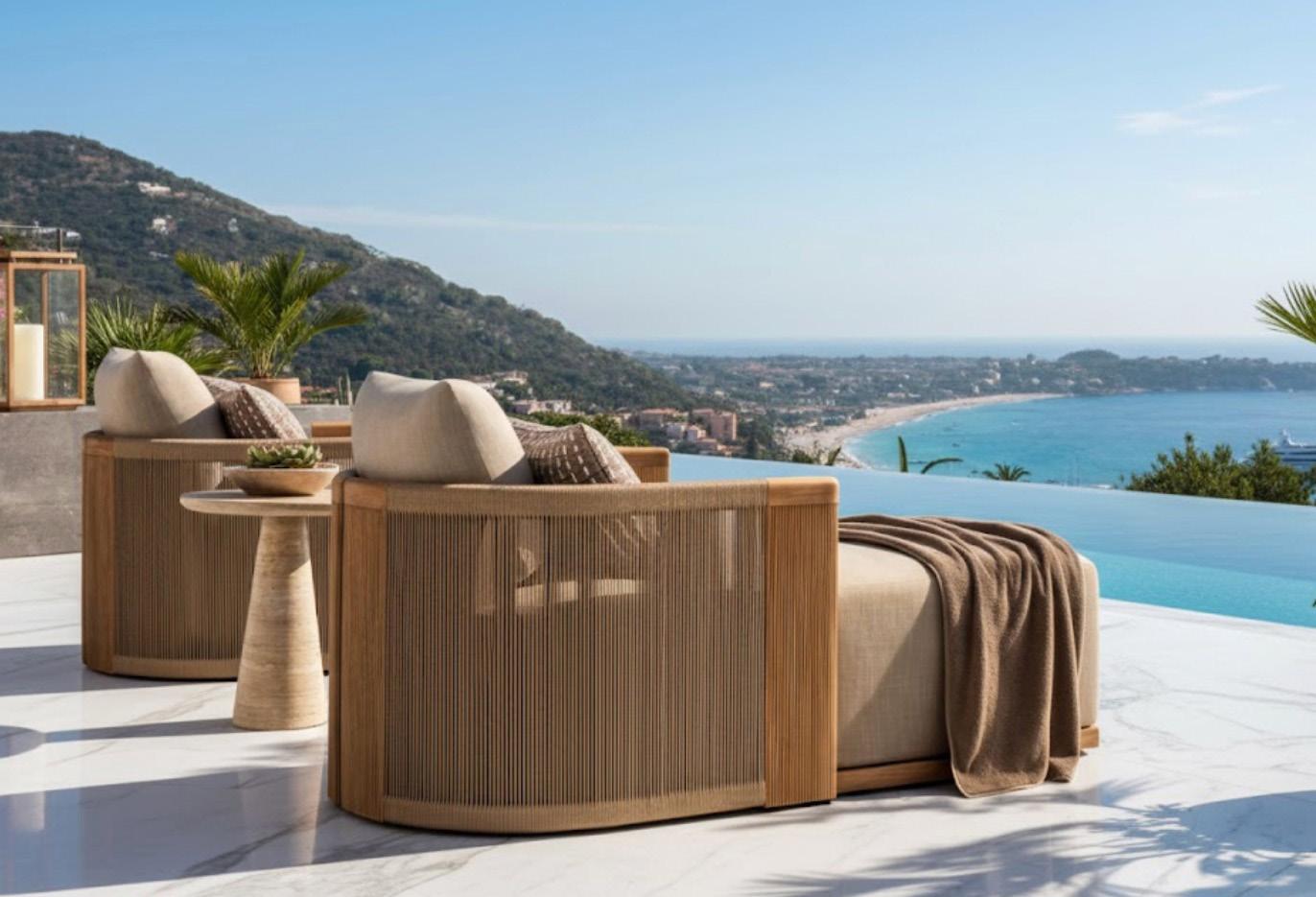
I bring a sense of curation — not just design, but a complete creative direction. My clients get an editoriallevel experience, from the moodboards and swatches to the final styling and photography. I also bring an obsessive eye for value. I know how to make something look like a million dollars without spending it. That combination of vision and practicality is where the transformation happens.
Your website emphasizes “smart upgrades, stylish storytelling, and maximizing value.” Can you share an example of how that philosophy comes to life in a real project?
One of my favorite examples is a Charleston home where we completely reimagined the outdoor space — transforming a backyard that no one used into the most popular room in the house. Rather than doing a costly
renovation, we focused on thoughtful, high-impact upgrades. We replaced the standard outdoor fixtures with wet-rated lighting that looked and felt interior, added a custom bar and entertaining area flanked by built-ins with warm backlighting, and created multiple vignettes for dining, lounging, and quiet conversation. It became an open-air extension of the home — stylish, functional, and completely livable. That’s the essence of what I mean by smart upgrades and stylish storytelling: design that elevates your everyday life and maximizes value without unnecessary construction or expense. It’s about seeing the potential that already exists and making it extraordinary.
Outdoor living has become a signature element of your portfolio. How do you approach designing exterior spaces with the same care
and creativity as interiors? A: I see outdoor spaces as the new living rooms. The same design principles apply — scale, texture, and mood. The difference is you’re designing with nature as your backdrop. I love to create exterior environments that feel like extensions of the home: draped pergolas, layered lighting, and furniture that feels custom rather than commercial. It’s about capturing that resort-level luxury in your own backyard.
If a client could take only one thing from working with you — one idea, one principle, or one experience — what would you hope it is?
That you don’t have to choose between beautiful and livable. Great design can be practical, personal, and aspirational all at once. I want my clients to feel empowered by the process — to see that with the right eye and strategy, you

can create luxury through intention, not excess.
What do you hope clients feel when they walk into a Bosworth-designed home for the first time?
I want them to exhale. I want them to feel like this is exactly how they’ve always imagined living — calm, grounded, inspired. There’s something incredibly special about seeing someone walk into their finished space and just smile. That moment of recognition — that “this is me” feeling — is everything.
You’re deeply involved with The LENS Foundation. What inspired you to join this mission, and how does it reflect your personal values?
The LENS Foundation is deeply personal to me because it’s rooted in
community and compassion — two values that guide everything our family does. My husband Jamie is one of the most giving people I know. When we moved to Charleston five years ago, he had the incredible idea to fulfill Christmas lists for children and families in need across the Lowcountry. What began as a small neighborhood effort quickly grew, and we soon partnered with The LENS Foundation, the nonprofit that supports the Charleston Police Department’s community outreach and youth programs.The foundation builds trust and connection between officers and the community — funding mentorship programs, youth engagement, and support for families in need. Through that partnership, we’ve been able to amplify our impact in ways we never imagined. Last year alone, we fulfilled more than 125 Christmas wish lists, raised
over $100,000, and brought together more than 80 volunteers from across Charleston. For me, it’s a reminder that giving isn’t seasonal — it’s a way of living. The LENS Foundation represents the best of what Charleston stands for: neighbors looking out for one another and creating a sense of belonging for every family.
As we approach the holiday season, what does meaningful giving look like in Charleston? How can families and neighbors make an impact beyond simply donating?
It starts with connection. Writing a check is wonderful, but showing up — wrapping gifts, delivering them, meeting the families — that’s what truly changes you. Charleston is such a tight-knit community, and the most meaningful giving happens when
Alia Bosworth and family. Photograph by Paula Cahalan
people engage personally. Even one afternoon of volunteering can ripple into something much bigger. That said, financial support is what allows The LENS Foundation to keep expanding its reach. A donation of $250 fulfills one child’s entire Christmas wish list. $1,000 can support Christmas for an entire family — providing not just gifts, but also basic household essentials many of us take for granted. There aren’t many donations you can make these days where you can see exactly where your dollars go and the impact they have right here in our community. It’s one of the most rewarding things I’ve ever been a part of, because every contribution — whether time or money — directly touches the lives of families who need it most.
Many of our readers are homeowners and community builders. What are three actionable ways someone in Charleston can support The LENS Foundation this holiday—whether volunteering, gift-giving, or hosting their own fundraiser?
There are three simple but powerful ways to get involved this holiday season.
First, donate directly to The LENS Foundation. Every dollar goes right back into the Charleston community — $250 fulfills one child’s Christmas list, and $1,000 supports an entire family with gifts and essential home supplies. You can scan the QR code on our materials or visit our site to contribute.
Second, volunteer to fulfill a child’s Christmas list. It’s one of the most rewarding experiences — shopping for gifts, wrapping them, and seeing the
joy they bring. It connects you directly to the families we serve and makes the impact feel personal and immediate. Third, help us procure corporate donations or sponsorships. Many local businesses and brands are looking for meaningful ways to give back during the holidays. Whether it’s a financial contribution, in-kind products, or employee volunteer hours, corporate support helps us reach exponentially more families across the Lowcountry. If you or your company would like to get involved, you can email me directly at alia@thestylescout.com
For families who want to give back but don’t know where to start, is there a story from The LENS Foundation that inspires you—and what’s the first step you’d suggest they take?
I’ll never forget a little girl who asked for nothing for herself — just a warm blanket for her grandmother. It’s a simple reminder that love and gratitude are universal. My advice is: start small, but start. Generosity grows when you act on it. I’m so energized by what’s ahead. Bosworth Custom Design continues to evolve, and the launch of Bosworth Bespoke has opened an entirely new chapter — allowing us to bring luxury outdoor furniture directly to consumers and eliminate the layers of retail markup that so often stand between great design and great value. We’re in conversations with a few notable tastemakers about exclusive design collaborations, and with several luxury resort properties about creating signature outdoor curations that marry craftsmanship, storytelling, and a sense of place. Those projects really capture what I love most — blending the editorial beauty of design with the
livability of everyday life. And as we look toward spring, I’m already encouraging clients to start now. With Charleston’s warm season just a few months away, this is the ideal time to order custom furniture so their spaces are ready to enjoy the full stretch of outdoor living.
Q: How do you see the role of the designer evolving, and what do you believe is timeless about the work you do?
The role of the designer is becoming part creative director, part strategist. Clients want vision, but they also want efficiency, transparency, and techforward solutions. What’s timeless is the emotional core — creating beauty that feels human, that tells a story, that lasts.
Ultimately, what do you hope your legacy will be—as a designer, a mentor, and a changemaker through The LENS Foundation?
I hope my legacy is about possibility — that you can build a life and a business rooted in both creativity and kindness. Design, at its best, is about how people feel in a space — proud, comfortable, inspired. Through my work, I want to give clients that sense of belonging and beauty every time they walk through their doors. And through The LENS Foundation, I hope to give that same feeling to children and families who need it most — to remind them that they’re seen, valued, and supported by their community. If I can leave behind spaces and stories that reflect both beauty and purpose — homes that elevate everyday life and a legacy of giving that strengthens the fabric of Charleston — that, to me, is everything.
Art of the Plate: A Conversation with
At Frannie & The Fox, nestled within the vibrant enclave of The Little Palm, Executive Chef Daniel Dalton III crafts more than meals—he creates immersive experiences. Each dish is a story, each aroma and texture a deliberate note in a culinary symphony, where even silence has weight and purpose.
Dalton’s work sits at the intersection of artistry and reflection. It is shaped by his personal history, refined aesthetic sensibilities, and the paradox of producing something exquisitely ephemeral: a meal that vanishes on the plate yet lingers in memory. For him, cooking is not only craft it is confession, dialogue, and a quiet exploration of what it means to connect through flavor.
In this intimate conversation, Dalton opens the doors to his kitchen and his philosophy. We discuss the inspirations behind his menus, the creative impulses that guide his hand, and the personal moments that inform every plate. From the overlooked ingredients that captivate him to the fleeting yet resonant experiences he hopes to impart, this is a glimpse into the mind of a chef who treats the table as both canvas and stage.
Step inside, and discover the artistry, precision, and heart that make dining at Frannie & The Fox a singular, unforgettable experience.

Executive Chef Daniel Dalton III
of Frannie & The Fox, The Little Palm
All photography by Marie Wisner
Interview by Editor Christina Coscia

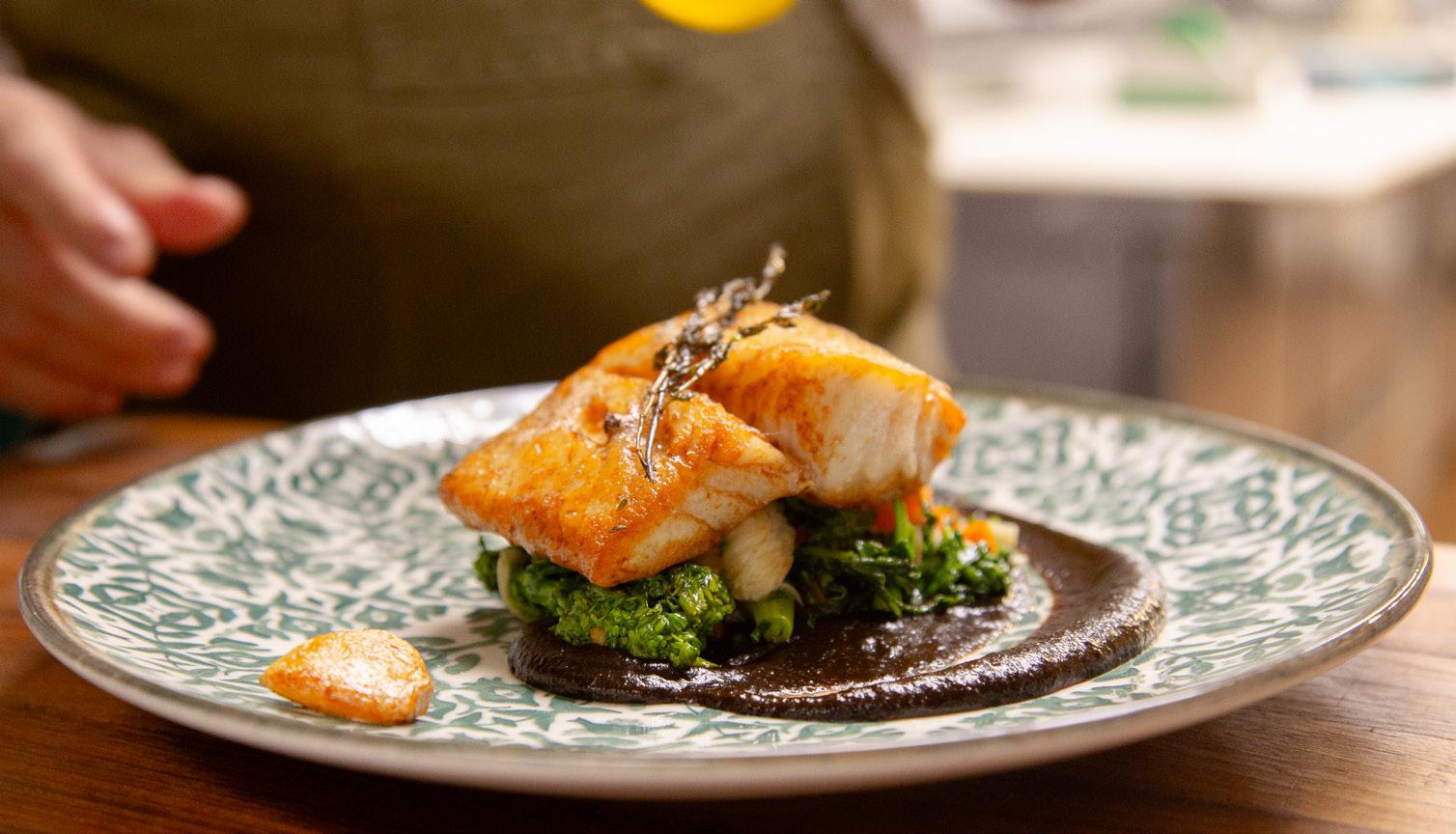
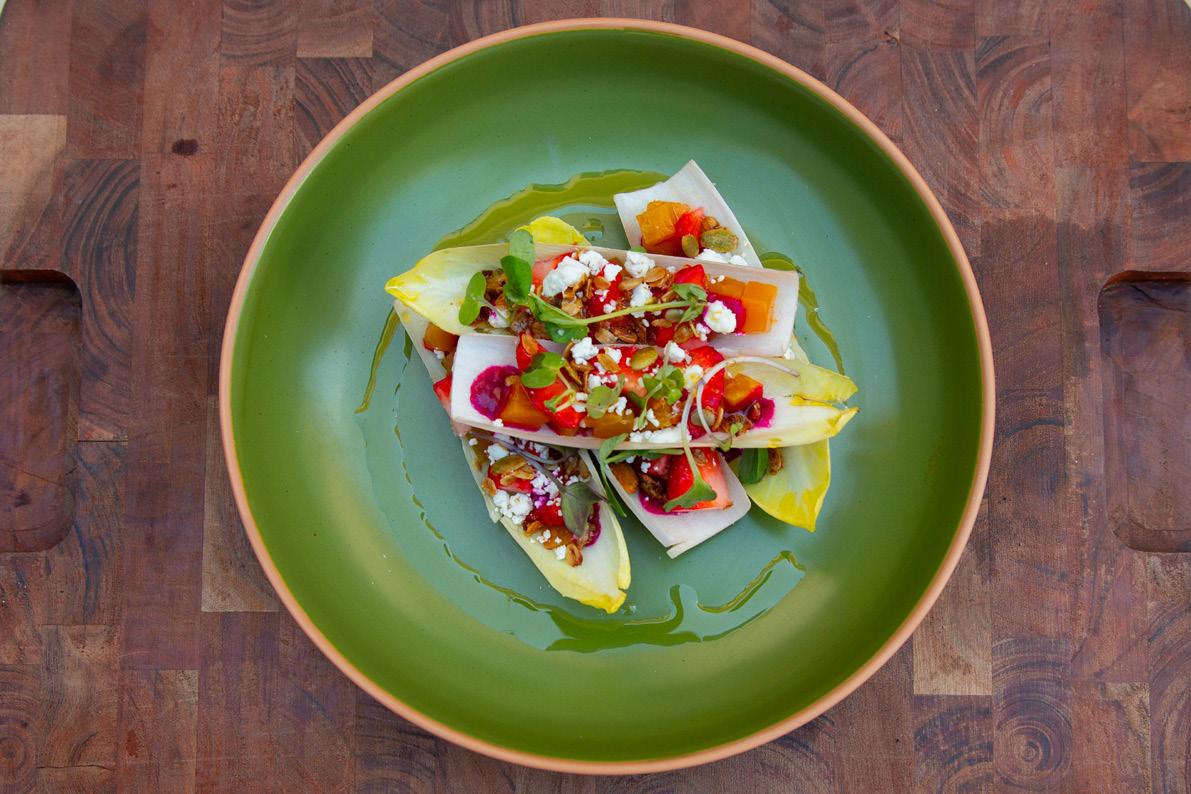
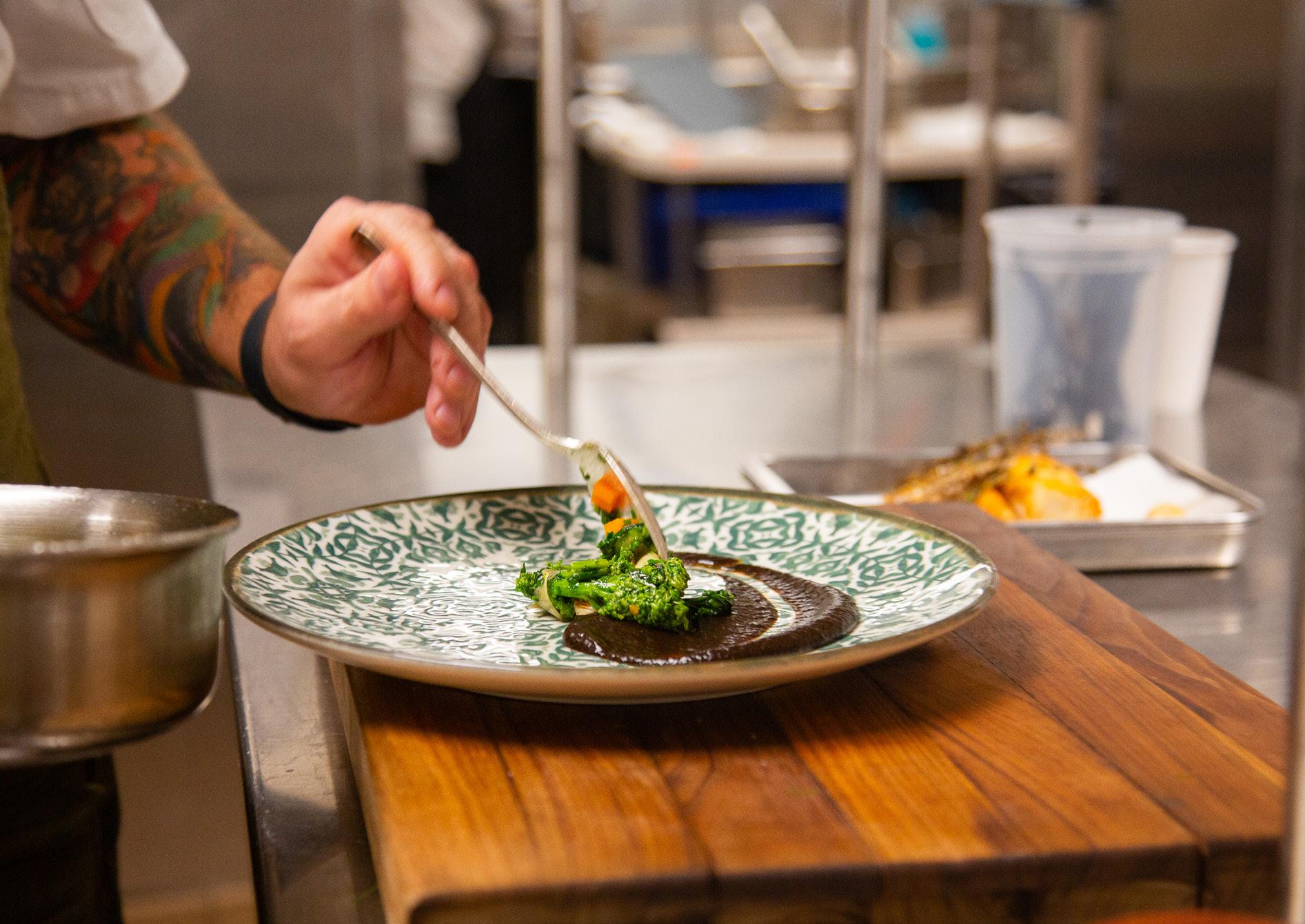
When you conceptualize a menu, do you envision it as a narrative arc, a sequence of emotional cues, or an abstract expression of your culinary ethos?
I often see a menu as a dialogue between memory and momentum. It’s not always linear, but it’s always intentional — each dish should evoke a feeling or spark a sense of place. Whether it’s rooted in tradition or sparked by a sudden burst of inspiration, the throughline is always flavor with emotional depth.
How do you navigate the delicate tension between honoring classical technique and pursuing radical innovation?
Classical technique is the foundation — it’s the grammar. Innovation is the poetry. I try not to chase novelty for its own sake but to stay curious, thoughtful, and fearless. Sometimes a whisper of innovation carries more weight than a shout.
How do you reconcile the fleeting, ephemeral nature of a meal with the enduring impression you hope it leaves on a guest?
The beauty of a meal is in its impermanence but its emotional imprint can be lasting. I’m less interested in the Instagram photo and more interested in the moment someone realizes a dish reminded them of home, or of a place they’ve never been but now want to go.
How has your biography - your upbringing, formative experiences, or unexpected moments shaped your approach to hospitality and gastronomy?
My earliest exposure to hospitality was through my grandfather’s garden and our family pub in New Jersey. But the real roots run deeper. My father was the oldest of 12 siblings, so I grew up in a household where large family gatherings were constant, and holidays meant feeding a crowd. The joy of cooking and serving others was built into our family culture. Later, working under chefs with uncompromising standards helped me realize how hospitality could be a vehicle for storytelling, culture, and healing.
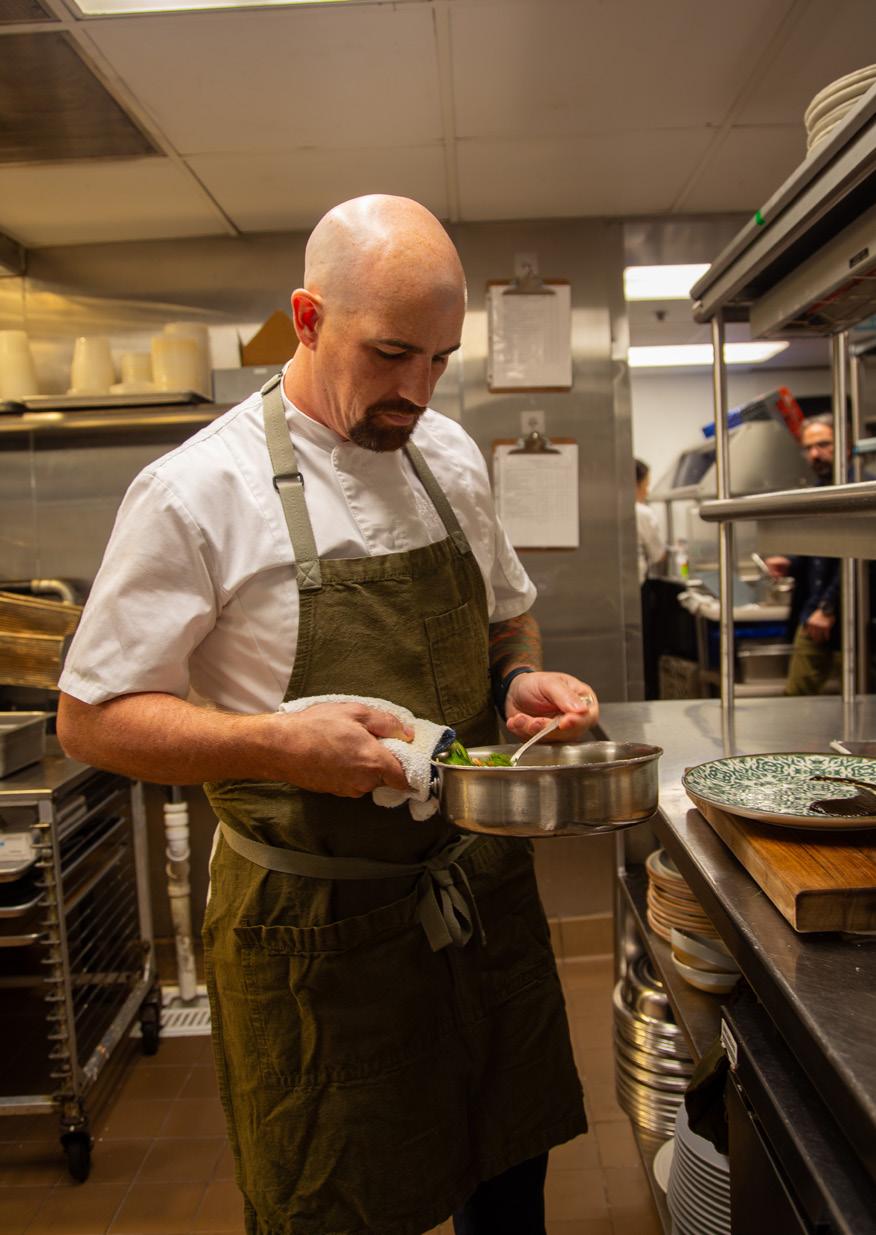
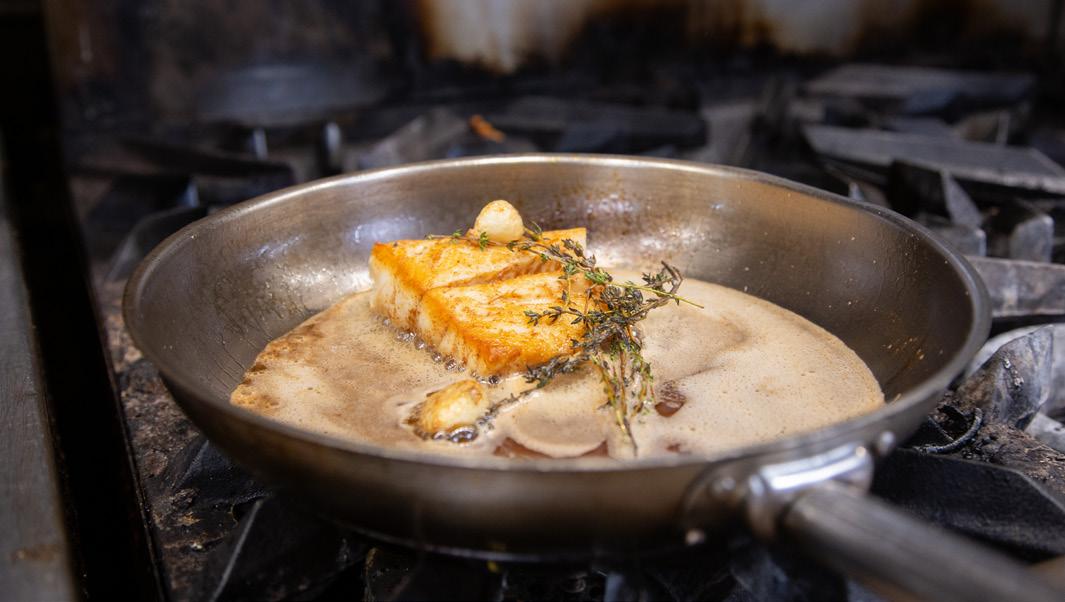

If you were not a chef, which other artistic discipline might have offered you a conduit for expression?
Music and design. Music for its emotional depth, rhythm, and structure — it mirrors service in a lot of ways: building, peaking, resolving. And design because so much of my world is spatial — plate design, kitchen design, even the flow of service — it’s all architecture in motion.
What chapter of your journey most defines you, yet remains invisible to those who encounter only your dishes?
The chapter between seasons — the moments I’ve spent mentoring
young cooks, redesigning systems, or building culture in quiet ways — that’s the work I’m most proud of. It’s often invisible, but it’s the mortar that holds the house together.
What does your future look like as a chef, and what do you hope to bring to the culinary world moving forward?
I see myself investing more in mentorship, sustainability, and in helping shape systems that support cooks beyond the line. I want to leave behind more than just recipes — I want to help build a future that makes this industry better for the next generation.
Looking back on your culinary journey, which achievements or
milestones are you most proud of and why?
Some of the proudest moments haven’t come with plaques. They’ve come when a line cook gets promoted, when a young chef finds their voice, or when you start to see a culture of accountability, passion, and pride take hold. It’s about creating impact within your walls, shaping cooks and chefs around you, just as you were shaped by those who came before. And it’s about impact beyond your walls, building relationships with farmers and producers who are as dedicated to their craft as we are to ours. That dual legacy, internal and external, is what I’m most proud of: knowing you’ve helped build something that lasts longer than any one dish.

Are there particular dishes, menus, or recognitions that you feel have defined your career thus far?
A few dishes have traveled with me across multiple kitchens, evolving with each stop. But more than a single dish, it’s the collaborative menus — created with producers I trust, chefs I admire, and my teams — that best define my career.
How have your previous experiences and roles shaped the chef you are today?
Working in kitchens from New York to Las Vegas, under chefs like José Andrés, Thomas Keller, and Floyd Cardoz, taught me discipline, cultural respect, and the power of layering flavor with intention. My
time at Augusta National Golf Club instilled a level of precision and elegance in execution that I carry with me daily. But it’s been these last few years — leading teams, building programs, opening properties — where I’ve found my true voice as a chef, mentor, and operator.
Are there non-culinary aesthetics - architecture, fashion, music, or visual art - that subtly inform your culinary decisions?
Music and architecture inform everything. Jazz for spontaneity and structure, Brutalist design for minimalism, and the warmth of midcentury hospitality design for comfort and elegance. I’m also drawn to the concept of “wabisabi” — beauty in imperfection.
How do you wish diners to feel as they leave your restaurant - what resonance do you hope lingers?
I hope they feel seen. Nourished. Cared for. The best meals leave an echo — something warm that stays with you long after the plates are cleared. That feeling of being deeply looked after, without pretense — that’s what we aim for.
What sets Frannie & The Fox apart, and The Little Palm for the culinary experience?
Frannie & The Fox is about warmth and fire — literally and emotionally. It’s a place where you can feel the
heartbeat of the kitchen in the dining room. Little Palm is breezier — playful and coastal, with tropical notes and a bit of escapism. Each has its own rhythm.
How does the environment and ethos of The Little Palm influence the way you approach menu design and hospitality?
The Little Palm’s identity leans into sunshine, lightness, and a coastal lilt — so the menu follows suit. We focus on clean finishes, playful ingredients, and seasonal brightness. Hospitality there is about transporting you — if only for a cocktail or two — to somewhere softer, somewhere you exhale. Even without a raw bar, there’s a breezy sensibility to the food and service that captures that coastal energy.
In your vision for Frannie & The Fox, how do you balance innovation with the intimate, signature experience diners have come to expect?
At Frannie, the innovation is often in refinement. We push boundaries in flavor, sourcing, and presentation, but never at the expense of comfort. That intimacy — the hum of the hearth, the aroma of wood smoke — that’s sacred.
In the quiet moments between service, do you ever question whether your creations exist to satisfy others or to address an internal restlessness of your own?
Service is exactly that — it’s the act of giving. Nothing is about you or your ego; it’s about nourishing others. Still, I think the best dishes come from that intersection — where something deeply personal

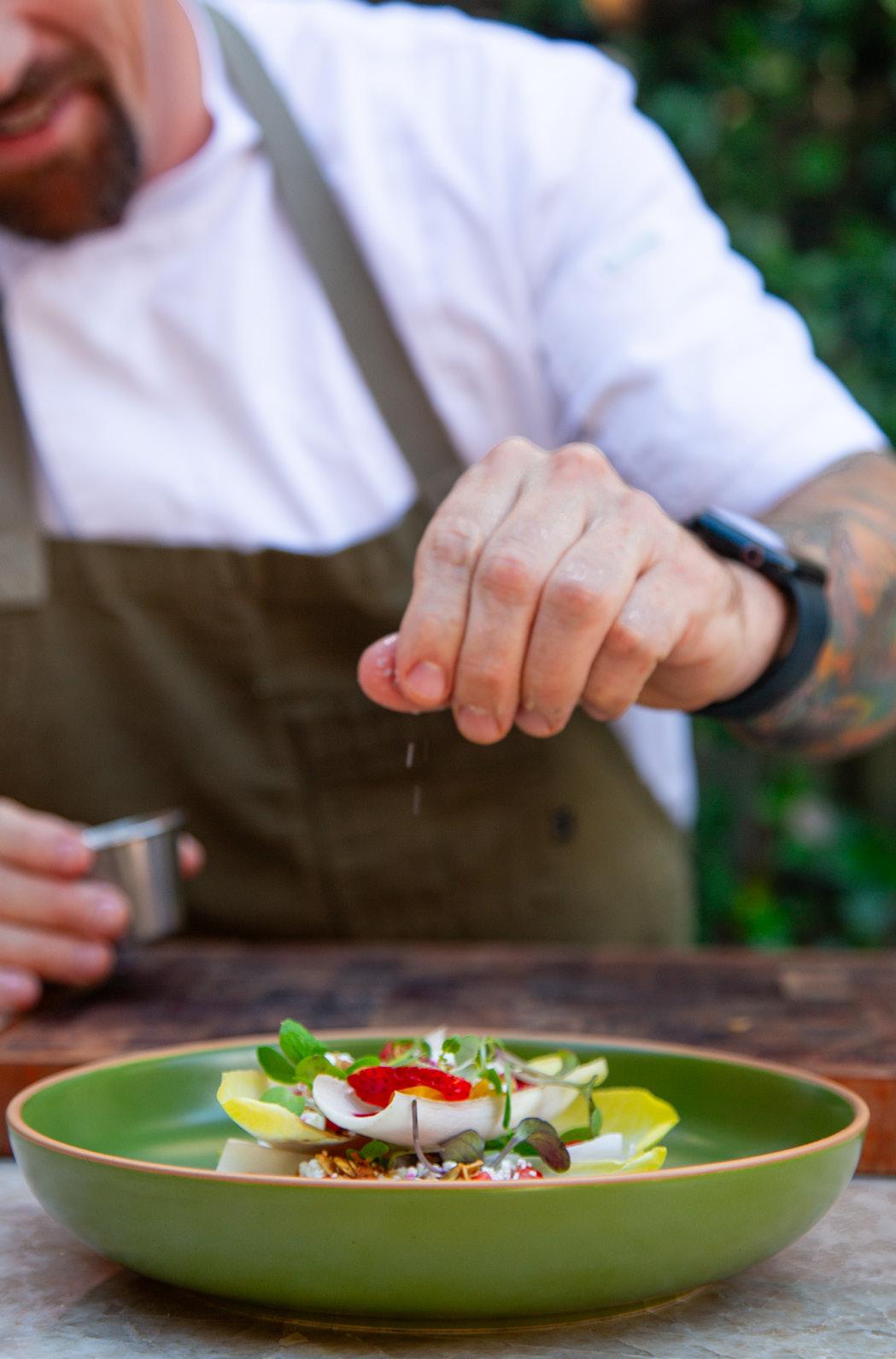
happens to also satisfy others. That’s when it feels like art.
If a single dish could encapsulate your interior life - your humor, anxieties, and desires – which would it be and why?
Paella — especially cooked over live fire. It’s communal, layered, and driven by instinct. Fire is unpredictable; it constantly changes, and to cook with it well, you have to understand and adapt to that dynamic. Paella can be anything you want it to be — humble or luxurious, precise or rustic. It reflects my need for structure and spontaneity at
once. There’s control in the setup, but once the flame hits, it becomes about feel, timing, and trust — which is not unlike the rhythm of a service or a life in kitchens.
How do you craft an experience that outlives its consumption, leaving a trace of your personality long after the meal concludes?
By evoking memory through familiarity and then igniting a spark through innovation of that memory. If a guest can feel something both known and new in a single bite, I’ve done my job. It’s about building bridges: from nostalgia to now.
Which ingredient, overlooked or underappreciated by most, captivates you and consistently compels exploration in your work?
Intention. It’s not something you can source or garnish a plate with, but it’s the most powerful ingredient in the kitchen. Intention drives how we source, how we season, how we treat a product from beginning to end. You can taste when something was cooked with care, with purpose — when it was more than just technique. Whether it’s a humble vegetable or a prime cut, intention is what transforms it. It’s what lingers after the last bite.



Behind the Lens: Heidi St. John Photographer
Your work exudes a timeless elegance. How would you articulate the visual language you’ve cultivated over the years?
My work carries an ethereal, romantic, and dream-like quality. I strive to create imagery that feels timeless—something that breathes emotion, movement, and depth. Fine art has a way of capturing and expressing internal feeling, and I want each photograph to reveal the essence and spirit of the person. My goal is for my work to evoke something amazing in people.
In a world saturated with imagery, what elements do you consider essential to create a photograph that resonates deeply with viewers?
For me, it’s all about presence and intention. I look for authenticity— the subtle gestures, the natural light, and the emotional undercurrent that bring a photograph to life. I often use words or imagery as guidance to inspire thought and emotion, giving viewers something to connect with beyond what they see.
How do you approach the delicate balance between composition and spontaneity in your shoots?
My eyes see fine art as I’m photographing. I prefer to go with the flow, I plan but allowing the energy and rhythm of the moment to guide me. I trust in things falling naturally into place—that’s where the magic happens.
Is there a particular emotion or narrative you aim to evoke in your subjects and audience through your photography?

I love capturing whether it’s a breeze through someone’s hair or a fleeting glance. It depends on what the photo session is about, but I always want to evoke a sense adventure and beauty in the moment with what we create..
Which artists, photographers, or experiences have profoundly influenced your approach to photography?
Cindy Sherman has always inspired me with her ability to fully immerse herself in a character through selfportraiture. Sally Mann’s raw and organic storytelling deeply moves me—the way she captures her
subjects, whether her children or something found in nature, feels both intimate and honest.
Sarah Moon’s work, with its painterly, ethereal, and mysterious quality, has also had a lasting influence. Her imagery feels like fragments of memory or fiction, often exploring themes of time, memory, and fairy tales.
From these artists, I’ve learned to keep stretching myself and not be afraid to try draw out side the lines. Slim Aarons also inspires me—I love the way he photographed his subjects in real moments. I recently came across his work and could

easily get swept away looking at the tones of the film, the fashion, the luxury, and the timeless designs. The people, the settings—he captured treasures that still feel alive today.
How do you integrate your personal experiences and worldview into your photographic work?
I once found a photo card as a teen—an image by Sarah Moon— and I held onto it forever. At the time, I didn’t know who she was, but the photo resonated deeply with me. Later, when I learned about her, I realized how much her perspective on art and style aligned with my own.
What is your process for conceptualizing a shoot, and how do you ensure each image stands as a compelling piece of art?
For myself or working with a client I like to lisen and learn about their vison. Every session begins with a vision—a spark of inspiration that often comes from nature, emotion, or light.
It makes me happy to hand in my work and see my clients love the results. I enjoy going to whatever lengths it takes to bring a vision together and make someone feel beautiful and seen.
Can you share an instance where a seemingly ordinary moment transformed into an extraordinary photograph?
Often, it’s in the in-between
moments—a glance, a laugh, or the way sunlight touches a face— where something extraordinary reveals itself. One of my favorite photographs came from such a moment, when everything aligned effortlessly and the emotion became visible in the air around us.
Reflecting on your journey, how has your photographic style evolved, and what factors have contributed to this transformation?
My style has grown from a focus on technical perfection to a love for emotional truth and fineart expression. Over the years, I have looked at style and tones I’ve learned to trust my instincts more deeply. Experience, intuition, and the willingness to be still and observe have shaped my method. I started using myself in some test shoots—it’s how I get new ideas. In some ways, it’s similar to Cindy Sherman, who uses herself and becomes the character, setting the stage. I’ve modeled, and by doing so, I understand how to better guide my subjects. It’s important to know what it feels like to be on the other side of the lens. I also have experience with makeup and styling, which all support my craft and help me bring a complete vision to life.
Are there emerging trends or techniques in photography that intrigue you and align with your artistic vision?
I’m drawn to blending photography with other art forms—exploring printed art pieces that I can paint
over or add texture to. Fine art is so fun; I’m playing with my photographs using paint—mixing color, texture, and theme—and I love that you never quite know where the art and photography might take you next.
What do you hope your photographs convey to those who encounter them, and how do you wish to be remembered in the realm of fine art photography?
I hope my photographs convey beauty, soul, and emotion—that they touch something inside the viewer. I want people to feel seen, understood, and inspired through my work.
I’d love to be remembered as the photographer who never quit exploring—the photographer who loved and always found a gem in anything that came her way. Fine art is so fun; it opens endless doors to explore creativity. I love mixing color, texture, and themes—it keeps me curious and inspired.
If you could encapsulate the essence of a single moment or emotion in a photograph, what would it be, and why?
It would be the light within someone—whether it’s happy and blissful, quiet and reflective, or simply very present. I’m drawn to capturing that spark, that sense of being truly there in the moment. It’s that quiet, golden space where light and emotion merge—where time pauses and the truth of who they are shines through. That’s the essence I always hope to capture.





Handcrafted Anatolian Jewelry





Rooted in the quiet charm of Sea Cliff, New York and inspired by the refined coastal spirit of towns from Newport, Rhode Island to Hilton Head, South Carolina, Na Mara Threads was born from a lifelong love of saltwater, sunlight, and the stories held by seaside towns. As a designer and mother, I created Na Mara Threads as an homage to heritage, craftsmanship, and the effortless beauty of coastal living.
Before launching Na Mara Threads, I spent more than two decades in fashion product development and design, working behind the scenes for notable International brands including Elie Tahari and Gap Inc. Over time, I felt called to create something more personal—pieces that carry a story, that feel both nostalgic and new, that invite people to slow down and live beautifully in the everyday. The experience and inspiration I gathered developing private labels for the iconic Southern Department Store Dillards helped motivate me to launch my own brand steeped in my love for coastal living. Inspired by a lifetime of coastal adventures, Na Mara Threads became that story brought to life.
Na Mara—meaning “of the sea”—is for those who carry the coast with them, whether
MaryEllen Clarke of Na Mara Threads

home is Charleston’s cobblestone streets, a New England harbor, or a small North Shore village on the Long Island Sound. My own coastal memories begin in childhood—driving to Montauk with my mother and wandering Gosman’s Dock—and continued into adulthood with weekends in Newport, sipping cocktails at Castle Hill with family and friends. Today, it’s weekend trips to Sag Harbor with my twin boys to visit my sister—moments that remind me that coastal living is not a destination, but a way of life.
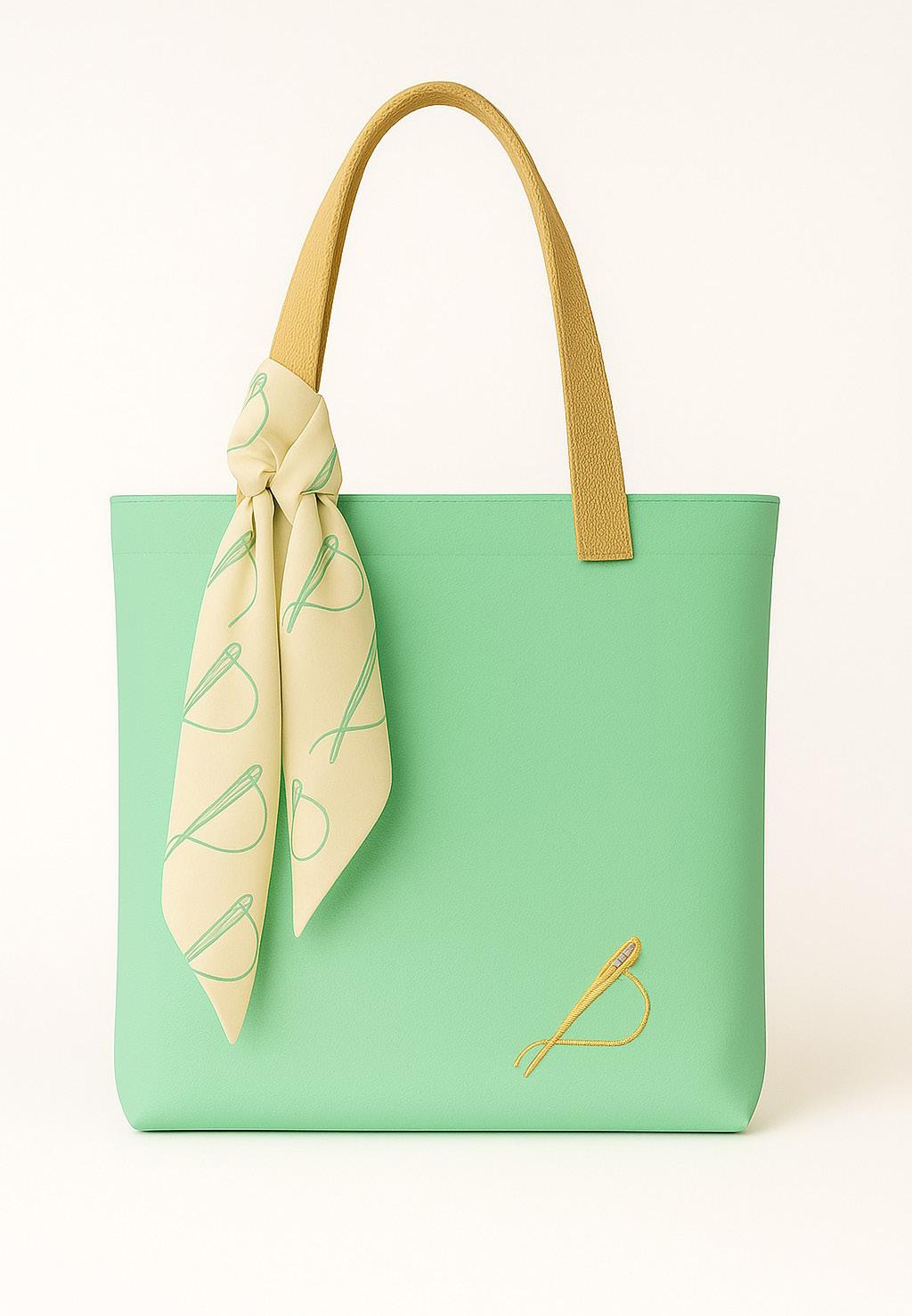


I believe the most meaningful pieces are the ones that feel personal—touched by hand, shaped by place, and designed to live real lives. Each Na Mara tote, scarf, and sun hat is created with intention: natural textiles, refined practicality, and subtle nods to the shorelines I love—Sea Cliff, Newport, Charleston, Hilton Head, Delray Beach. The Spring 2026 palette draws from hydrangeas in late summer, weathered dock planks, sea glass, mint-tinted tides, and the soft beige of sun-bleached sand.
To me, coastal style isn’t about resortwear or trends—it’s about how life feels by the water: a canvas bag tossed into the back of a boat, a cotton scarf lifted by the breeze, a straw hat resting on a sun-worn porch rail. It’s about craftsmanship and comfort. Tradition and salt air. Family and summers that never quite leave you.
I am honored to share this collection with Peninsula Magazine and the Charleston community—where tide, history, and heart come together in the most beautiful way.
TOO HOT TO HANDLE
What inspired the creation of Too Much to Handle, and what do you hope listeners carry with them after each episode?
Too Much to Handle was born from that feeling so many of us have — that we’re “too much” for the world, when in reality, that’s our magic. We wanted to create a space where humor, honesty, and curiosity could coexist without apology. Whether we’re talking about pop culture, relationships, or the chaos of everyday life, we hope listeners leave each episode feeling seen, a little lighter, and reminded that being “too much” is actually just being real.
When you first envisioned the podcast, was there a particular story, conversation, or idea you felt compelled to explore? How has that original vision evolved over time?
Initially, we wanted to explore the conversations that happen behind closed doors — the unfiltered girl talk, the cultural commentary, the humor that comes from honesty. Over time, it’s evolved into something bigger: a blend of storytelling and community. We’ve found this rhythm where laughter meets introspection, and it’s taken on a life of its own. The show now mirrors the evolution of our own lives — always changing, always curious.

of connection with listeners who are joining the conversation from afar?
Charleston has such a distinctive character. In what ways does the city, its culture, or its community influence the tone and spirit of your show?
Charleston has this beautiful duality — it’s refined and rooted in tradition, yet buzzing with creativity and new voices. That balance mirrors the tone of our show. There’s a Southern warmth and humor in how we approach topics, but also a modern, slightly irreverent energy that keeps it fresh. We love highlighting local stories and businesses, so Too Much to Handle feels like a love letter to Charleston and the people who make it special.
Podcasting is inherently intimate. How do you cultivate a sense
We speak to our audience the same way we’d speak to a friend over wine — unfiltered, warm, and curious. That intimacy comes from honesty. Listeners can sense when you’re being authentic, so we don’t shy away from vulnerability or humor. The magic happens when people DM us saying, “That episode felt like you were talking directly to me.” That’s the kind of connection we aim for.
Your show balances spontaneity with intention. How do you maintain that equilibrium between candidness and thoughtful structure?
We go into every episode with a loose structure — the anchor

points we want to hit — but we allow the conversation to breathe. Some of our best moments happen when something unplanned sparks laughter or reflection. It’s a dance between preparation and flow, but that spontaneity is what keeps it real.
Vulnerability is central to your work. Are there moments where sharing your own experiences fundamentally transformed an episode or the dialogue with your audience?
Absolutely. The most transformative moments are always the ones where we let the walls down. Whether it’s talking about relationships, burnout, or identity, sharing our truths has invited listeners to do the same. There’s something powerful about realizing your personal story can unlock someone else’s healing or self-reflection.
Your listeners often feel like an extended community. How do you nurture that sense of belonging and keep the conversation reciprocal?
We listen as much as we talk. Our DMs, comments, and feedback shape what we do — it’s a two-way dialogue. We treat our audience like insiders, not just listeners. When someone feels part of the story, they become part of the movement. That sense of belonging is everything.
Has audience feedback ever surprised you or reshaped the way you approach a topic or frame a conversation?
Definitely. Sometimes an episode we think is lighthearted ends up resonating deeply, or a casual comment sparks a whole new conversation. Our audience isn’t afraid to tell us what hits — or what misses — and that honesty has made the show sharper and more intentional.
From the initial spark of an idea to the final episode, what does your creative process look like? Is it meticulously planned, or guided more by intuition?
It’s a mix of both. We start with a running list of topics — cultural moments, listener questions, or things that have been on our minds — and then we build from there. The structure gives us direction, but intuition guides the storytelling. The best episodes come from what feels alive in the moment.
How do you determine when a topic truly embodies the “Too Much to Handle” ethos, and how do you transform that challenge into compelling storytelling?
If it makes us laugh, think, or debate — it’s Too Much to Handle. It’s about leaning into what’s messy, complex, or over-the-top in a way that feels honest and human. We love taking something that might seem frivolous and unpacking the truth beneath it — that’s where the real storytelling lives.
Consistency is key in podcasting, yet inspiration can ebb and flow. How do you sustain both discipline and creative vitality


across episodes?
We treat it like both a creative outlet and a commitment. Discipline keeps the show on track, but curiosity keeps it vibrant. When we’re feeling uninspired, we go live life — talk to people, travel, listen, observe. The world refuels us. You can’t create interesting conversations if you’re not out there living them.
In your view, what elevates a podcast from entertaining to truly artful — the kind of show that lingers in the listener’s mind long after it ends?
It’s when a show dares to be both meaningful and messy. Artful podcasting happens when storytelling meets emotion — when you’re laughing one minute and reflecting the next. It’s about creating a feeling that stays with someone after they hit pause.
Looking ahead, where do you see Too Much to Handle evolving? Are there new formats, collaborations, or themes you’re excited to explore?
We’re exploring new storytelling formats — more visual elements, live recordings, and deeper dives into the Charleston creative scene. Collaboration is a big focus, too. We love bringing in voices that challenge or complement ours. Ultimately, Too Much to Handle is evolving into a full-on lifestyle platform, not just a podcast.
For anyone thinking about starting a podcast, particularly here in Charleston, what guidance would you offer on finding one’s voice and building an authentic audience?
Start messy. Perfection kills creativity. Speak to one person — not the whole internet — and build from there. Charleston has such a unique mix of voices and stories; lean into what makes yours distinct. Authenticity will always outperform polish.
In a year from now, where do you both see yourselves with your
A year from now, we see Too Much to Handle expanding its reach — hosting live events, collaborating with brands that align with our values, and continuing to build a community that feels seen and celebrated. The goal is to keep evolving while staying rooted in why we started: to remind people that being “too much” is exactly

KULTURA
Kultura Charleston shines with warm, attentive ser vice that makes ever y guest feel like family. Chef Nikko blends Filipino traditions with creative flair, using locally sourced ingredients to honor both heritage and the Lowcountr y. Bold flavors come through in dishes like turmeric-brightened adobong dilaw and refreshing kinilaw, where fresh seafood is lifted with citrus and vinegar.
More than a restaurant, Kultura is a gathering place where community, culture and creativity come alive.


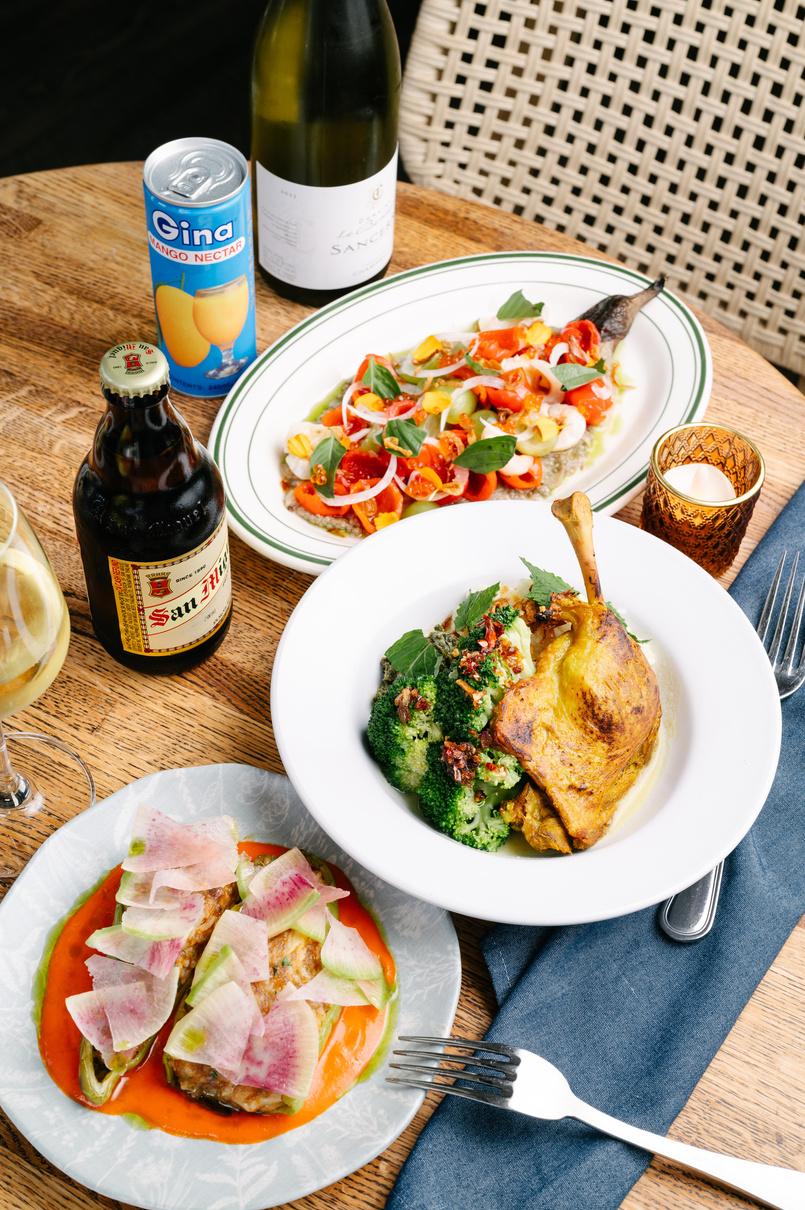

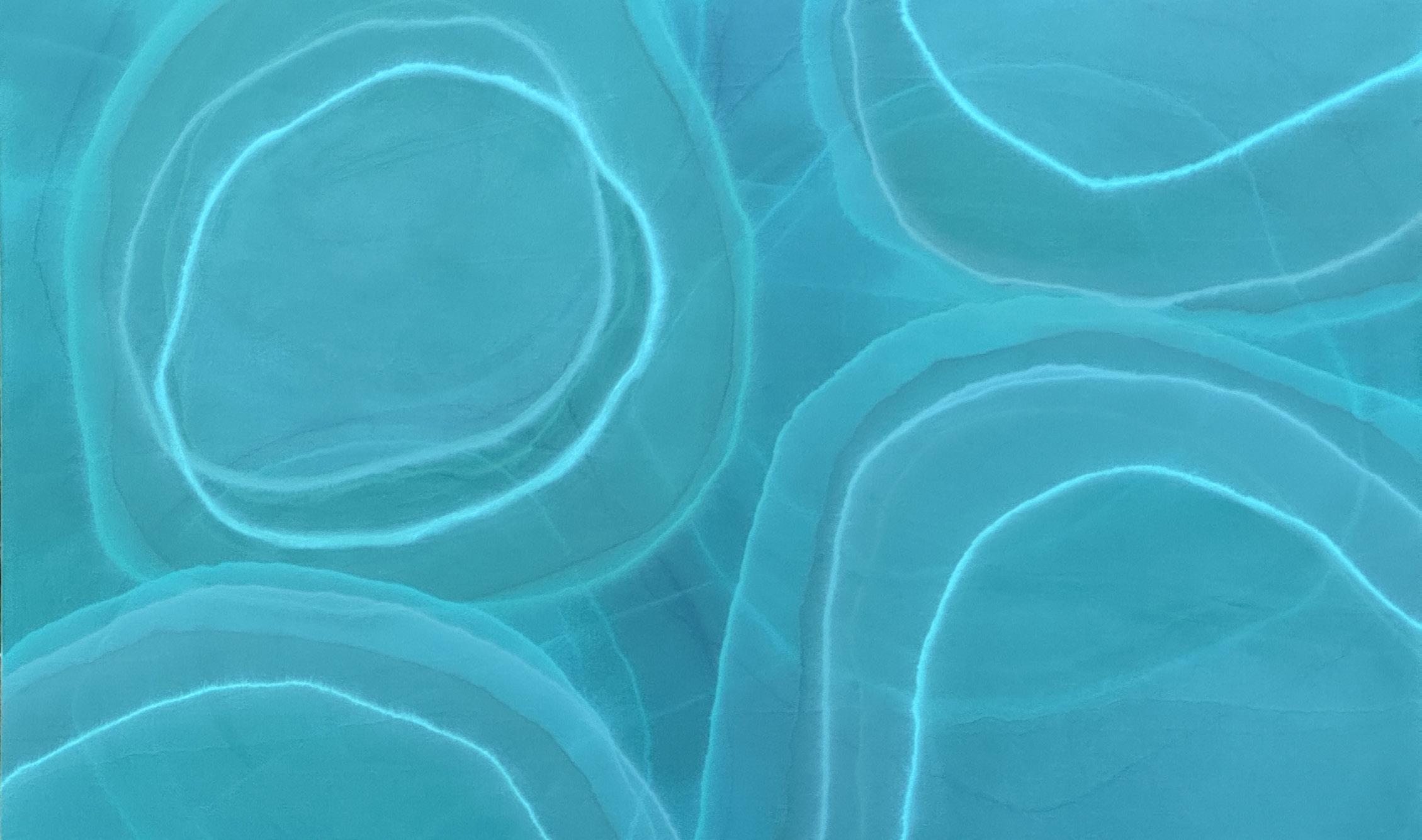

72 King Street, Charleston, South Carolina
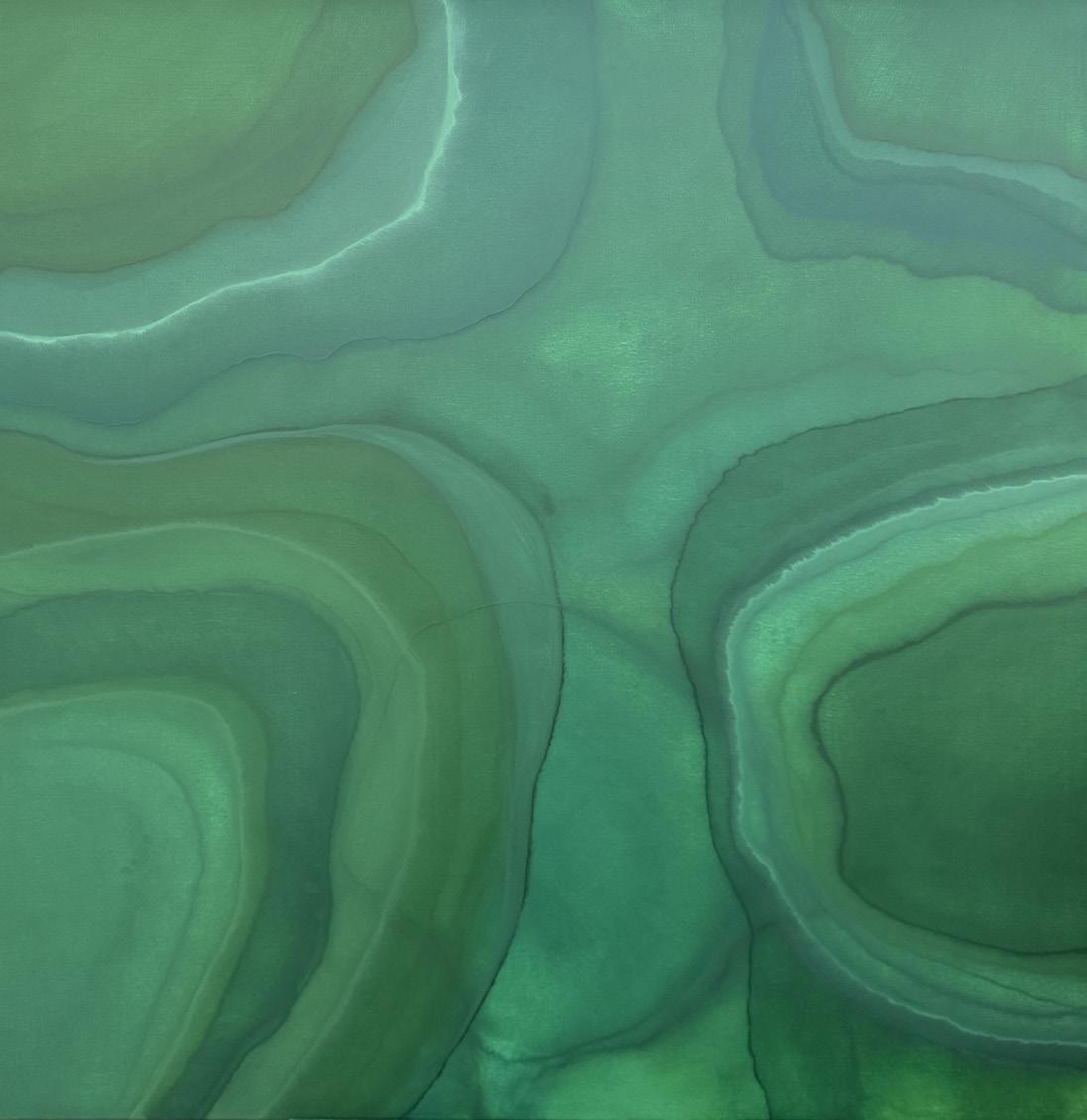

In the Ether, acrylic on canvas, 48” x 40”
Twilight, acrylic on canvas, 48” x 48”
Gossamer, acrylic on canvas, 48” x 30”
Herbly Wonderful Culinary LLC
B Y C H E F W Y A T T G A U S


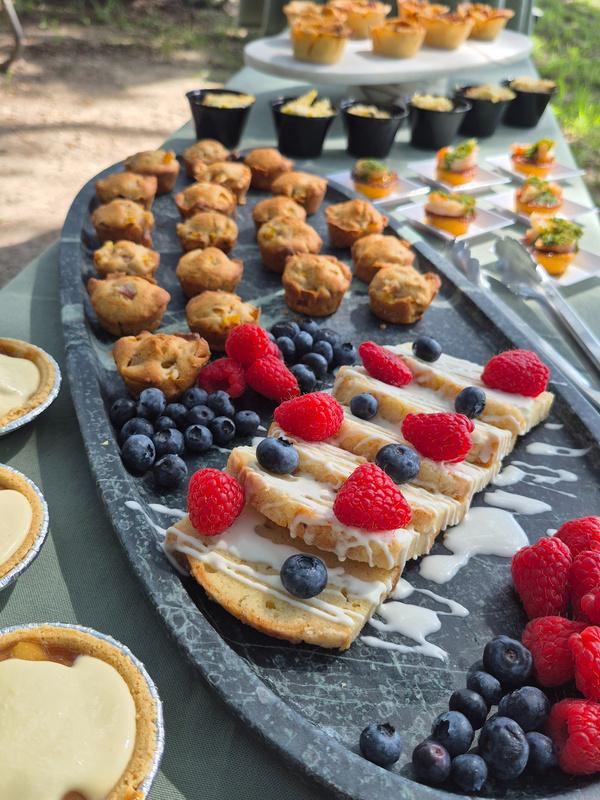
A wonderful way to dine
Wi t h He r bl y Wond e r f u l C u l i n a r y you
ge t to re l a x a nd e n j oy you r eve n t s
wi t h ou t wor r y I c re a te spec i a l
m e m or i e s t h rough l oc a l food c r a f ted
u si n g wor l d wi d e c u i si n e s .
H e r b l y w o n d e r f u l c u l i n a r y c o m
W y a t t g @ h e r b l y w o n d e r f u l c u l i n a r y c o m
5 8 5 - 6 6 4 - 0 2 7 6

Seyahan: A Journey of Craftsmanship and Connection


“Seyahan” means “traveler” in Ottoman Turkish - and true to its name, the story of this Charleston jewelry brand has been quite a journey.
Founded in Istanbul by Matthias Weimer, a German from Bavaria, and his wife Laura, who grew up on a pecan farm in rural Georgia, Seyahan was born from a shared love of artistry, history, and the beauty of the handmade. What began with a single store in Istanbul - soon expanding to three across Turkey - has become an internationally recognized brand, with pieces shown and sold in Paris, London, Los Angeles, and New York, before finding its true home in the American South. Today, their flagship boutique at 57 Broad Street in Charleston embodies everything the couple envisioned from the beginning: authenticity, artistry, and human connection.
Though Seyahan’s jewelry has been featured in Elle, Condé Nast, and admired across continents, the heart of the brand remains rooted in the artistry of Turkish makers. From Turkish-Armenian goldsmiths and Aramaic silversmiths to women’s cooperatives weaving delicate filigree in Anatolia, Seyahan works with some of the most gifted artisans in the world. Each pendant, ring, and bracelet carries within it centuries of inherited skill - the kind of mastery that can’t be rushed or replicated.
Their Charleston boutique captures that same spirit. Bathed in natural light, the space glows with antique furniture and crystal chandeliers, creating an

atmosphere that feels elegant yet approachable - more like stepping into a welcoming salon than a traditional store. It’s a place where time slows down, stories are shared, and the experience feels personal from the moment you walk in. “Everyone is welcome,” says Laura. “We want people to feel comfortable - to take their time, to talk, to explore. Jewelry should always feel intimate.”
That philosophy has earned Seyahan a reputation among its patrons as Charleston’s best jewelry store for customer service, uniqueness, and craftsmanship. Their guests often describe their visits as memorable and heartfelt, praising not only the beauty of the


jewelry but the sincerity of the people behind it. As one customer put it: “This is the most beautiful jewelry store I’ve ever been to. The pieces are breathtaking, but what makes it special is how genuinely kind and welcoming the owners are. They treat you like an old friend - I can’t wait to come back.”
In a world that moves quickly, Seyahan stands for the art of slowing down - cherishing the handmade, the enduring, and the human. From the workshops of Istanbul to Broad Street in Charleston, every Seyahan piece is a testament to the journey that brought it here - a story of skill, heritage, and connection that continues to shine in every facet of their jewelry.

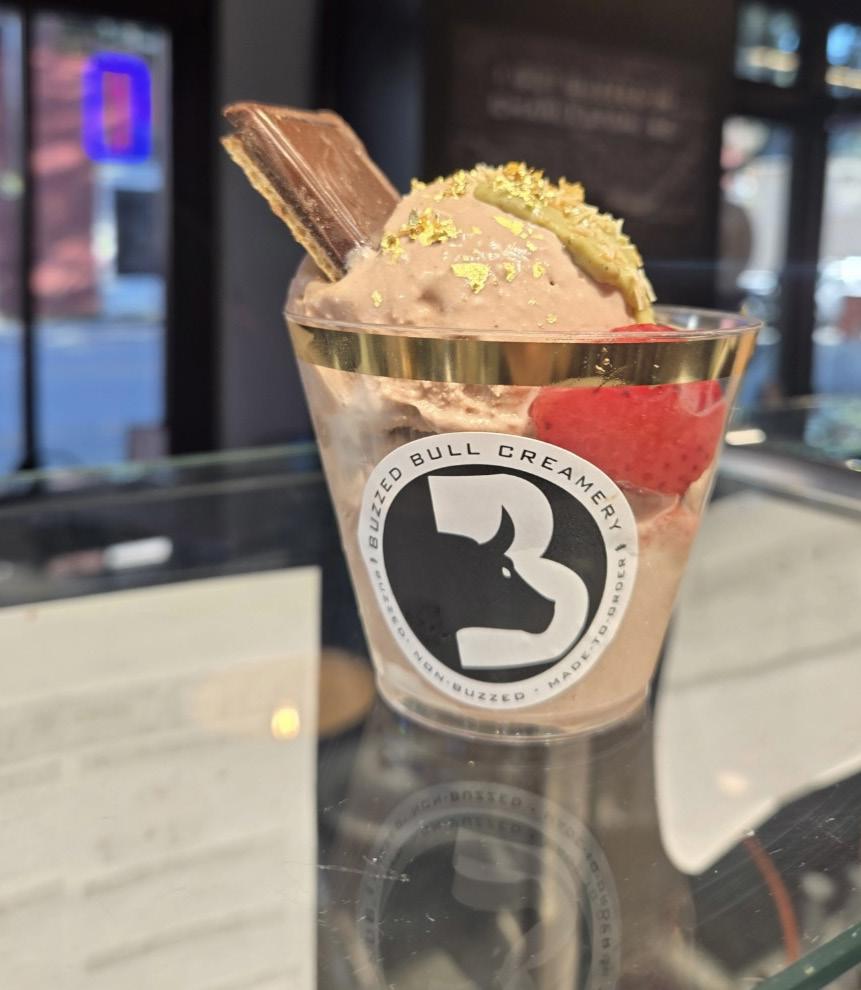


Model: Broughan Simmons
@itsbroughan

Agency: Premiere Model Management of Charleston
@premieremodel_csc
amypremieremodel@gmail.com
Photographer: Amanda Smith
@what_the_fstop_photography
Amanda@whatthefstopphotography.com
